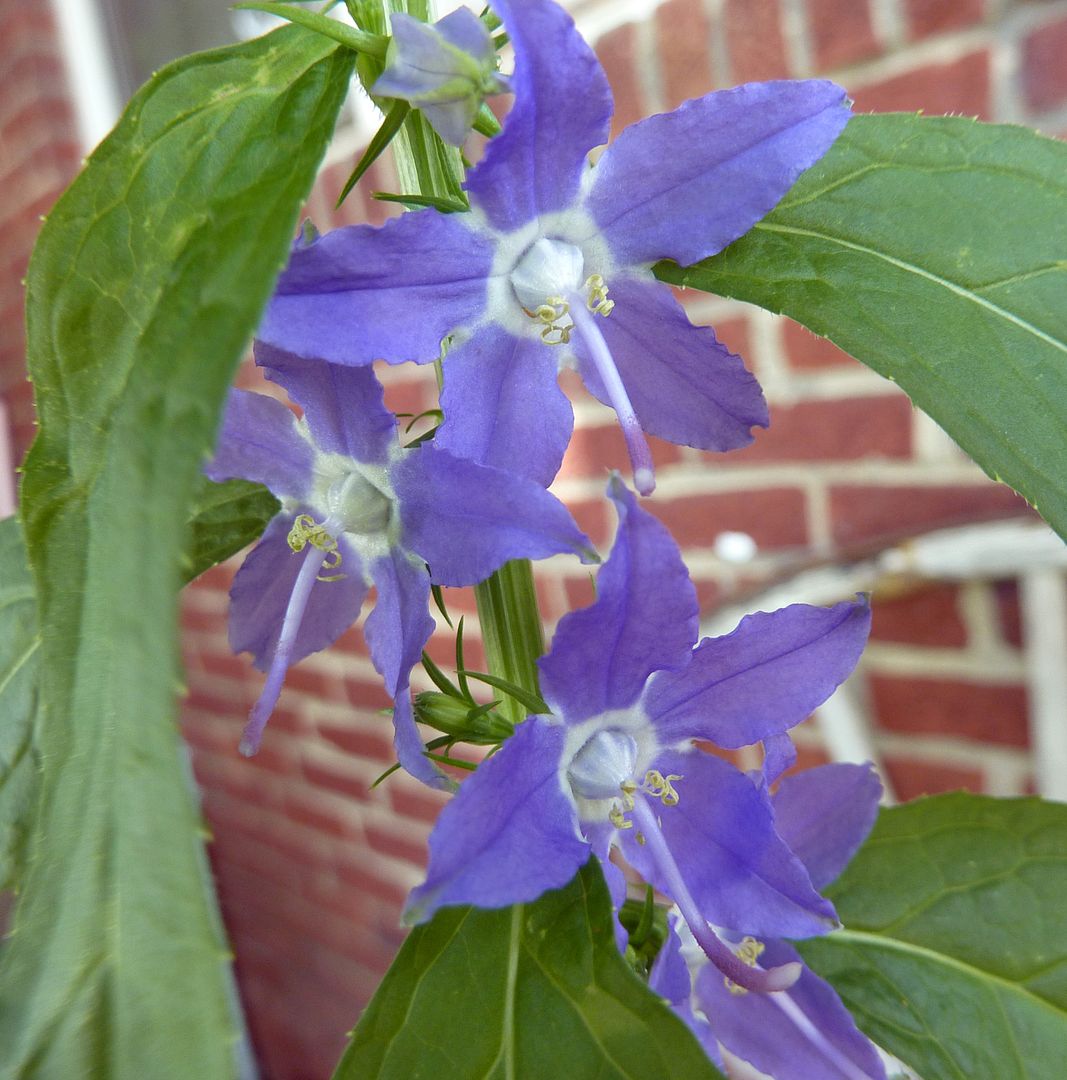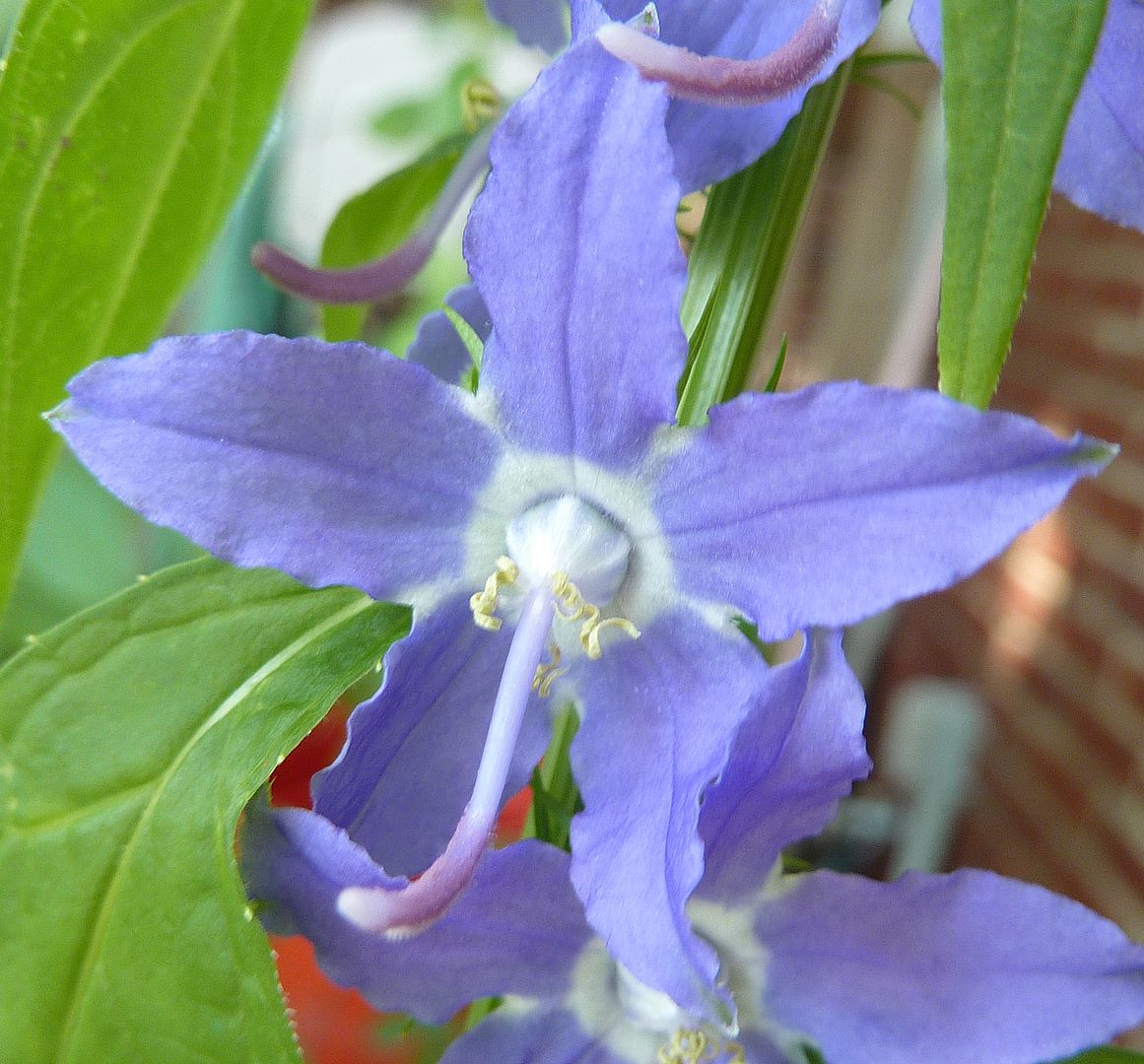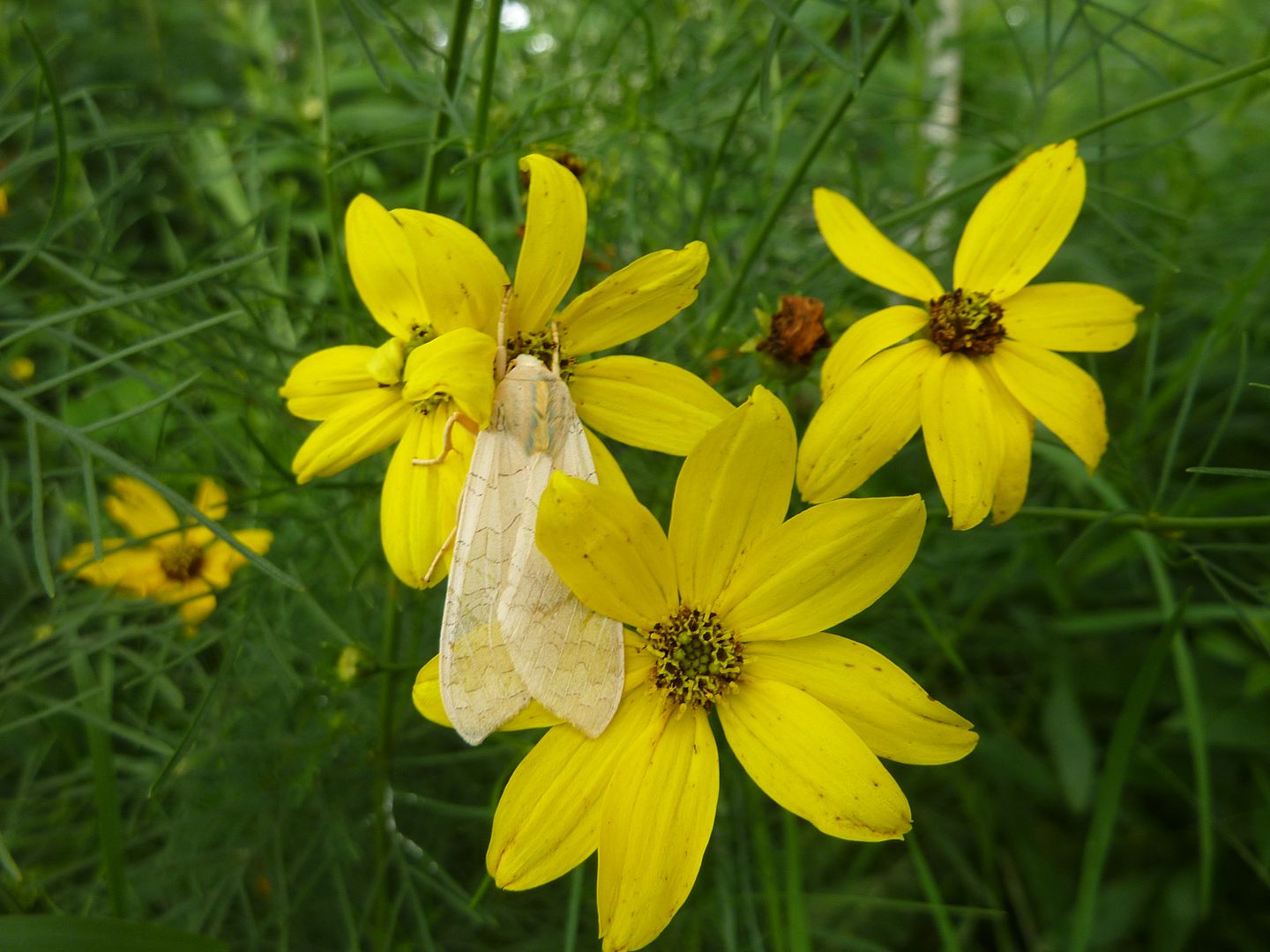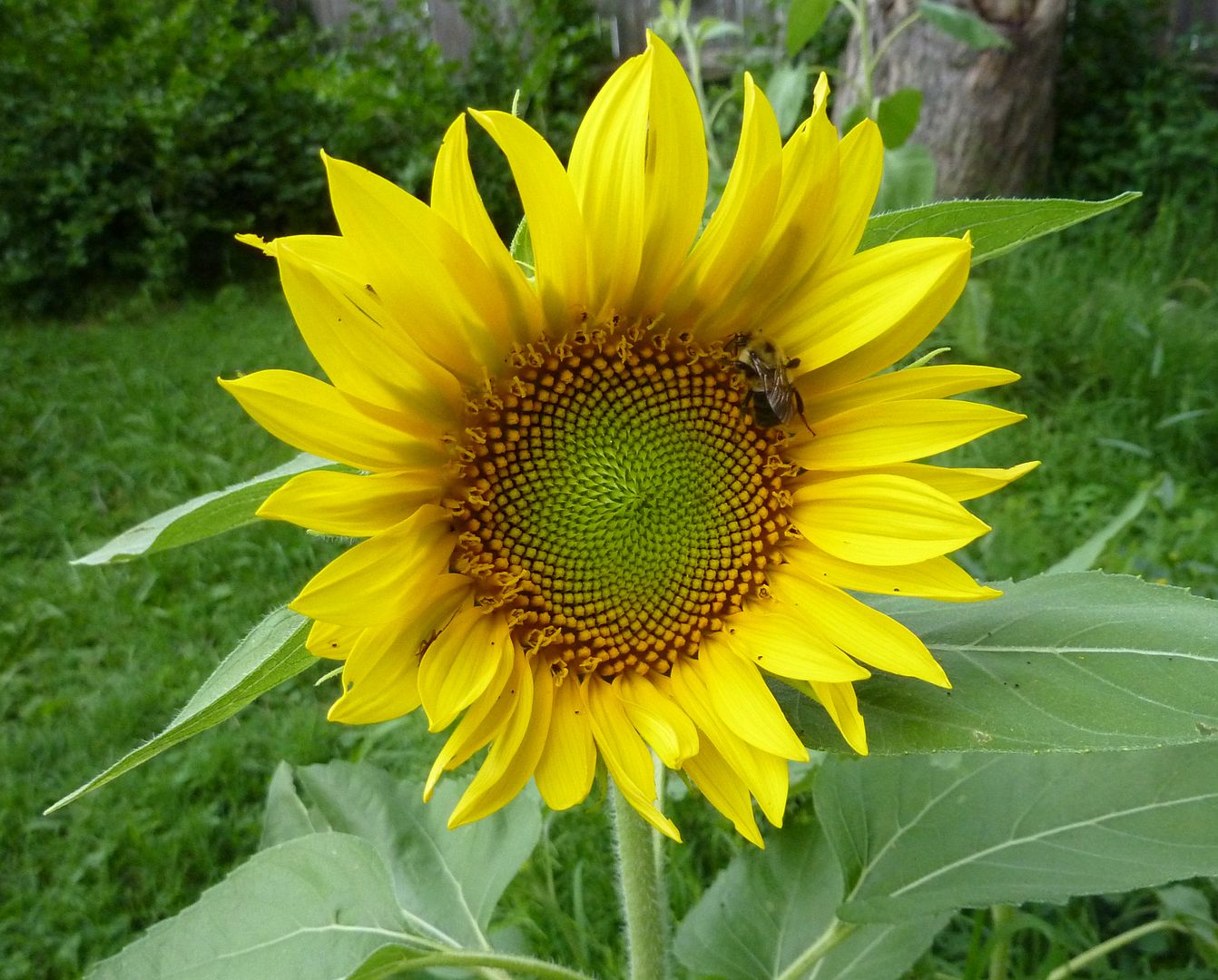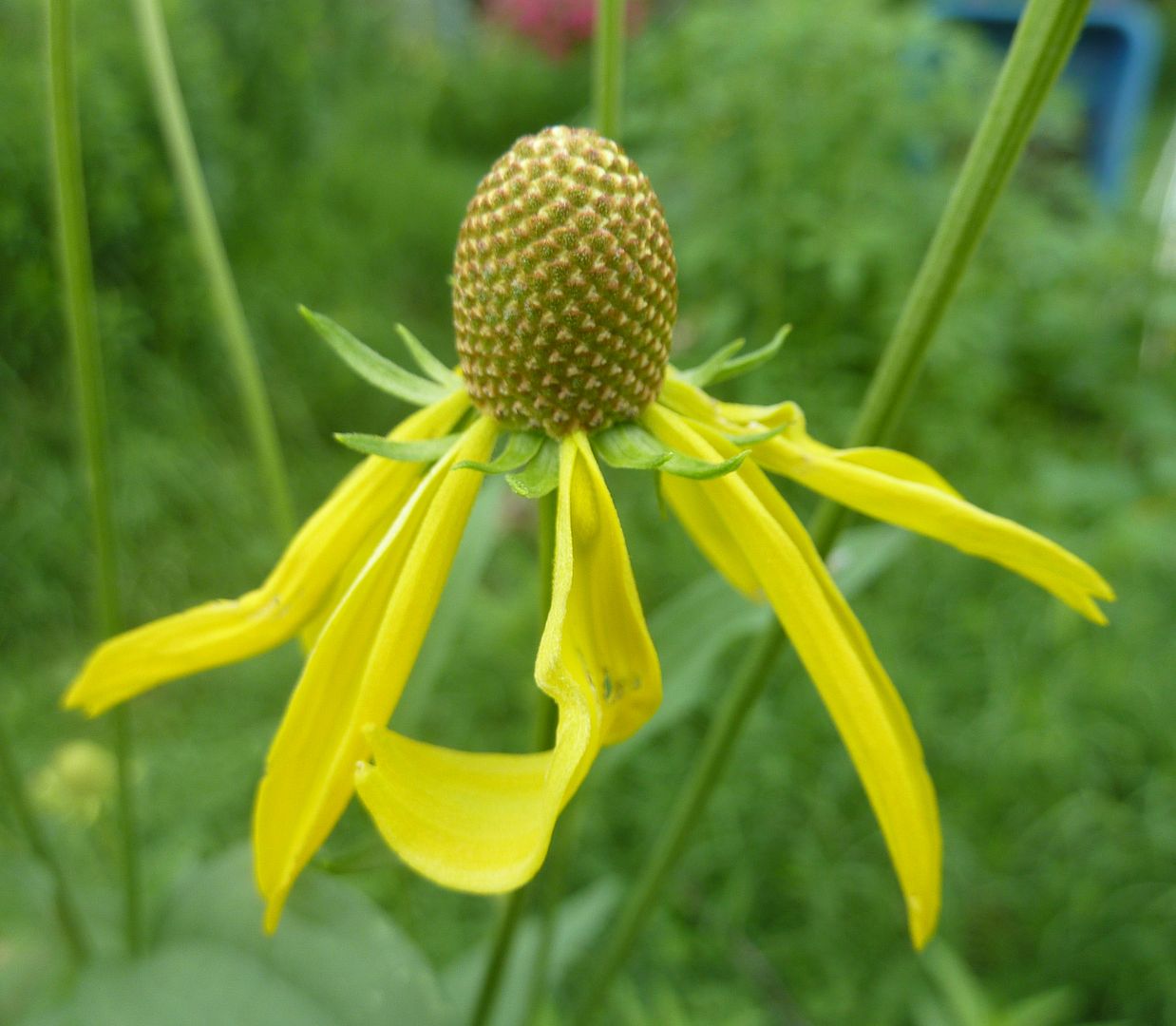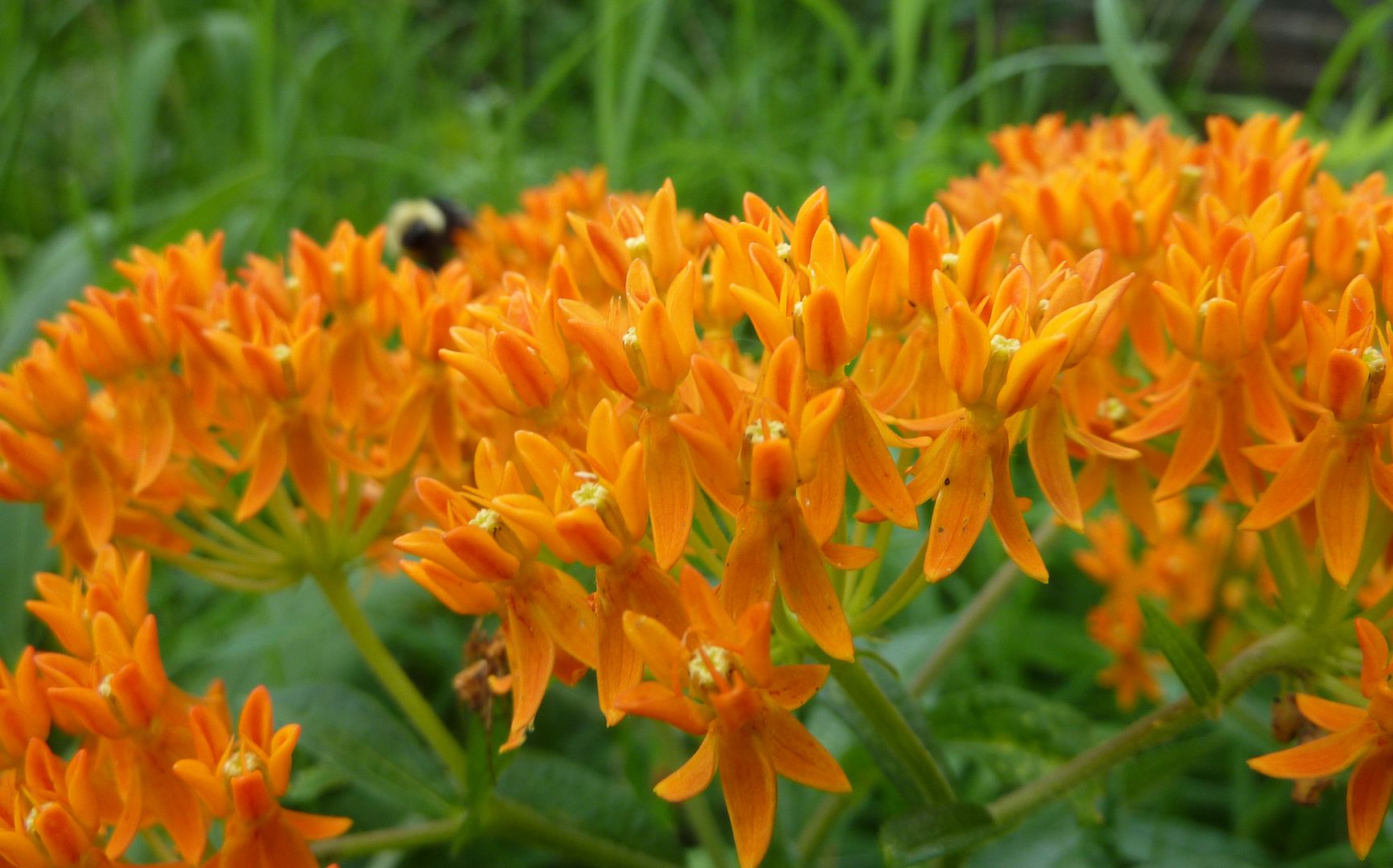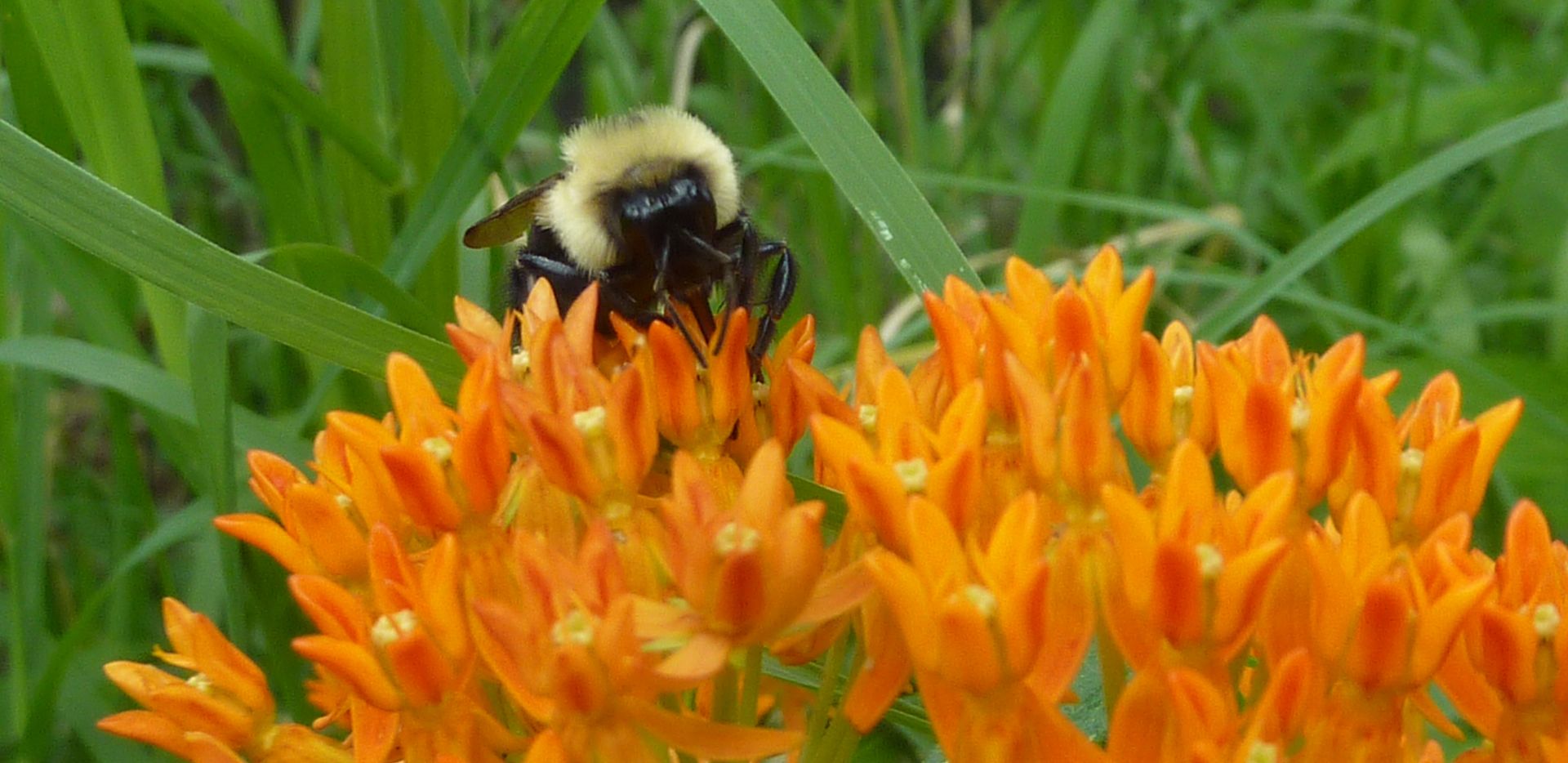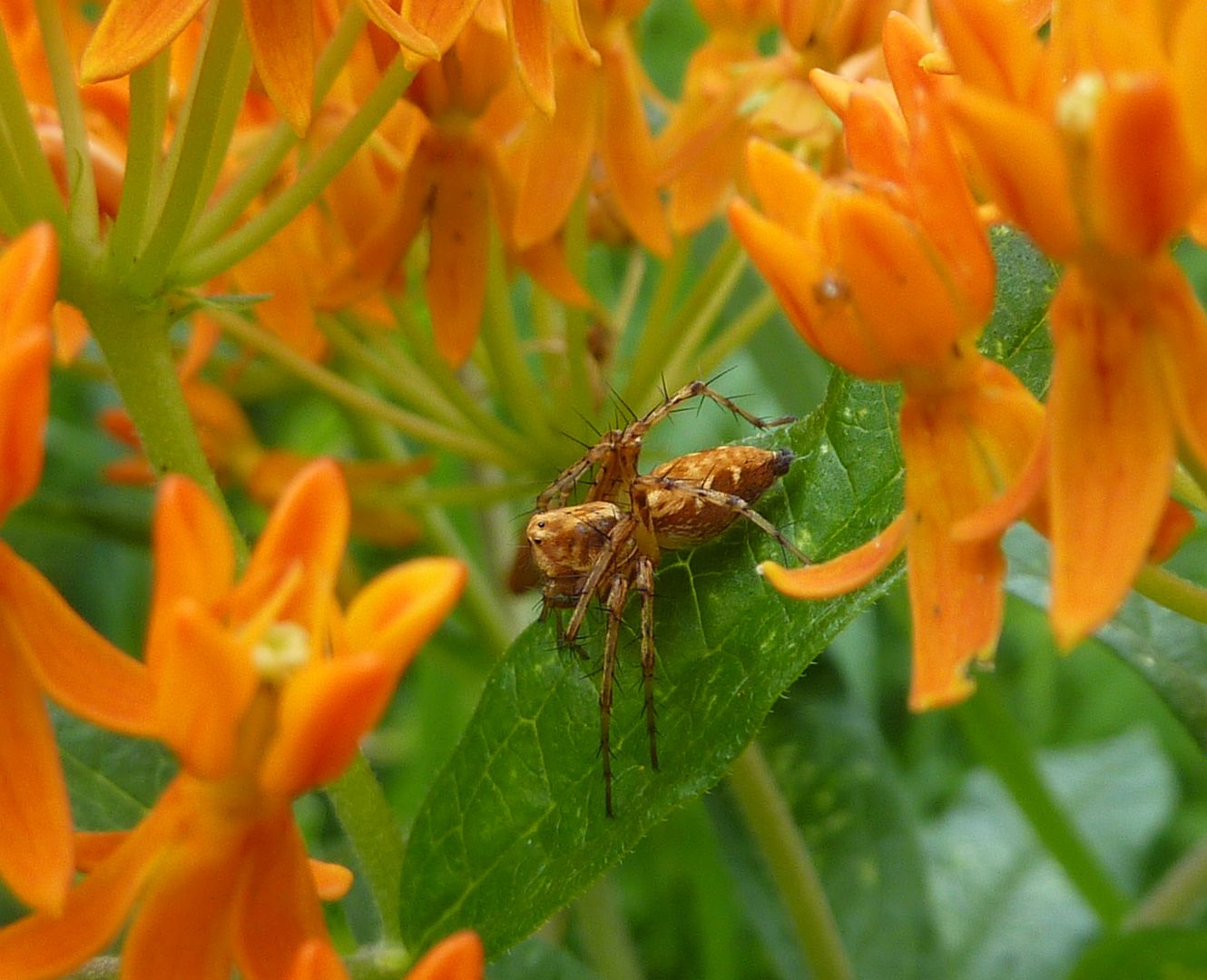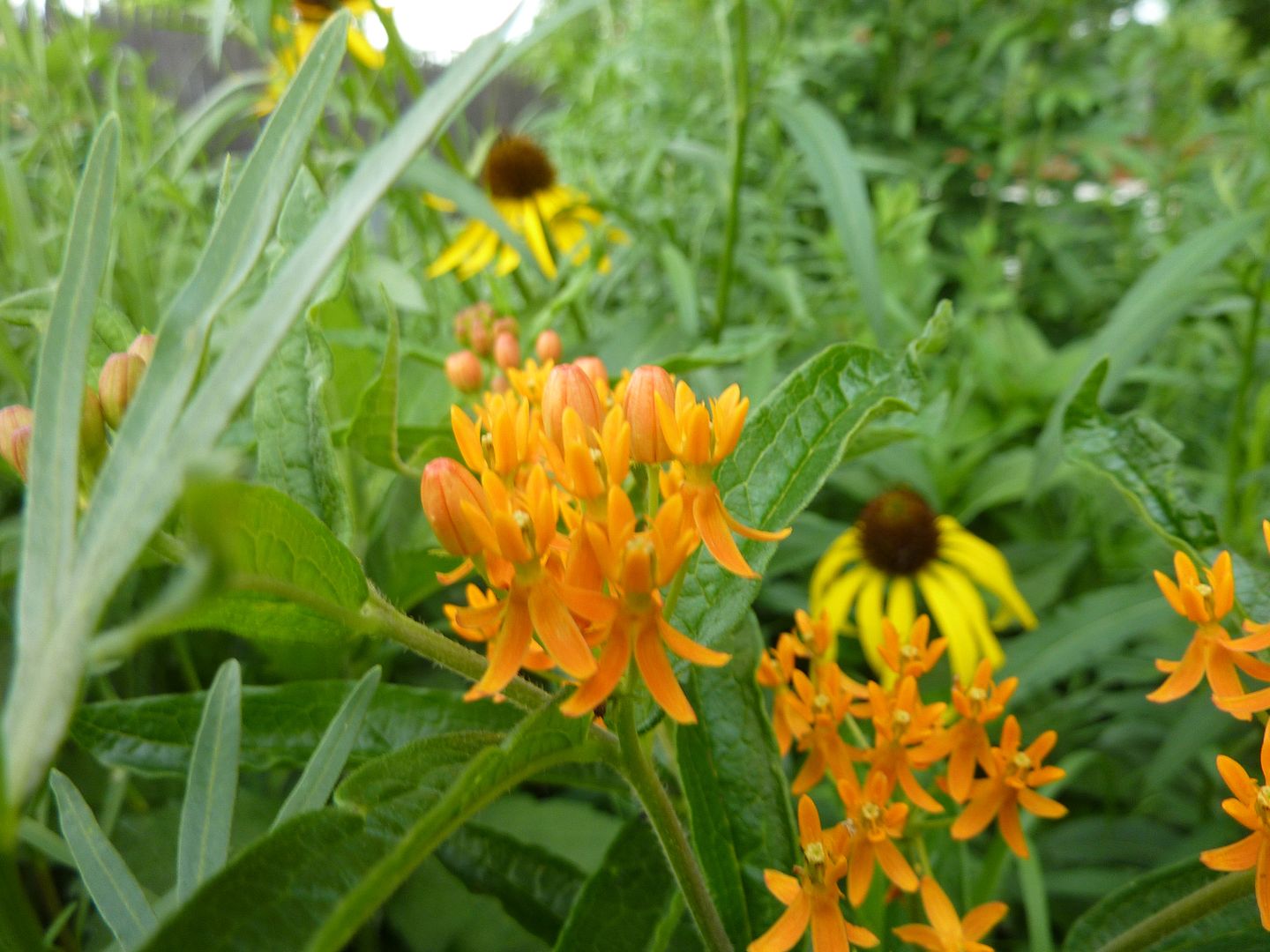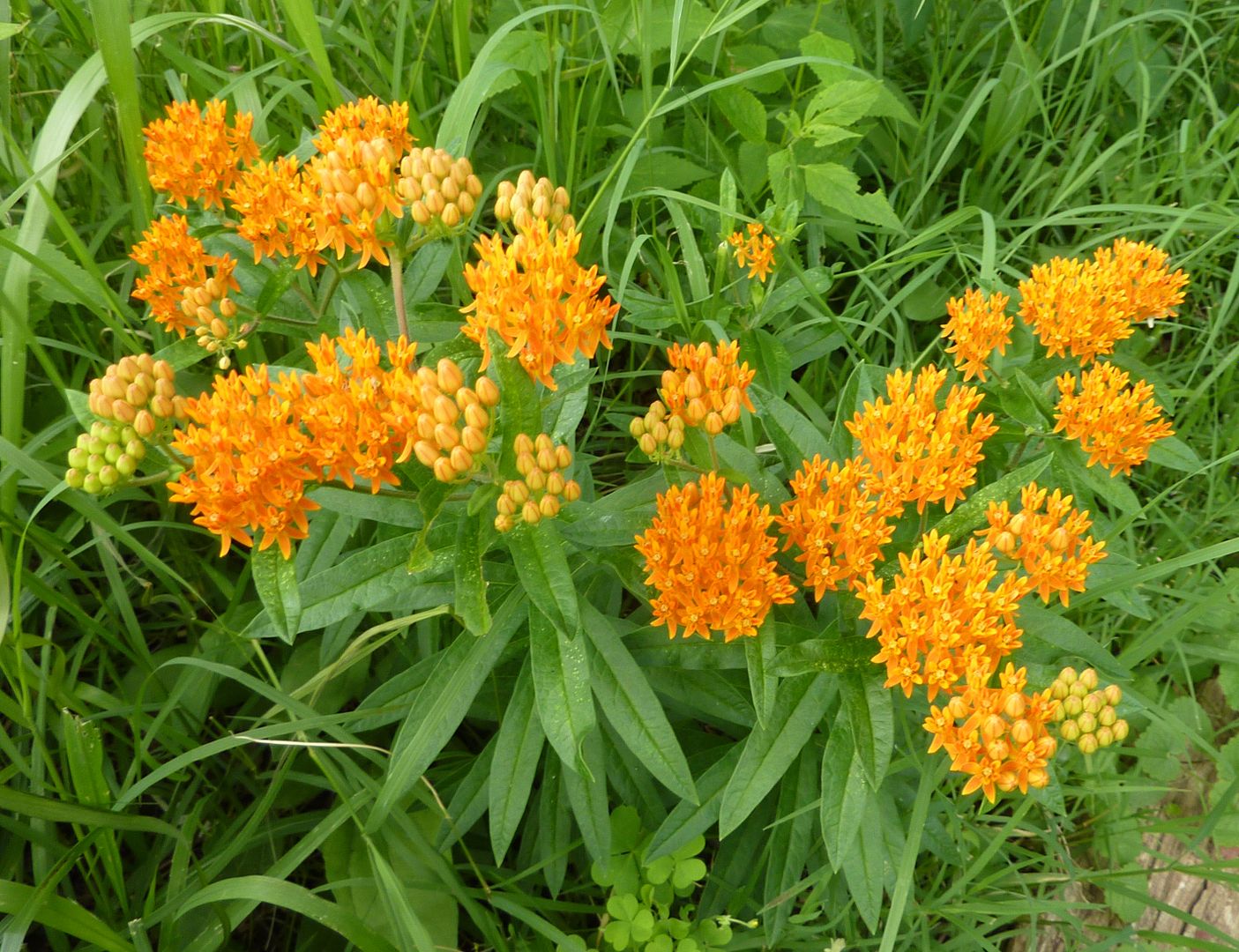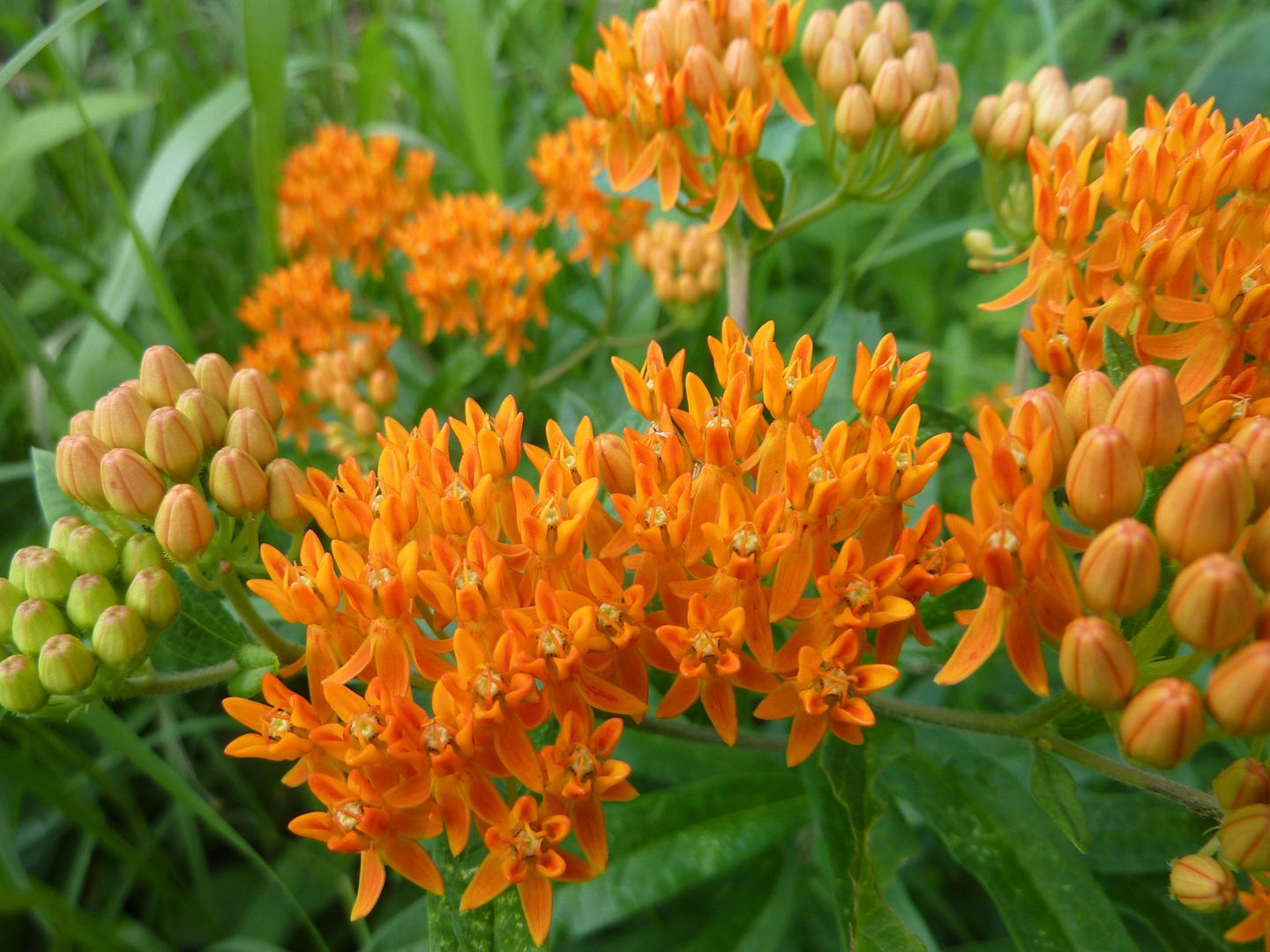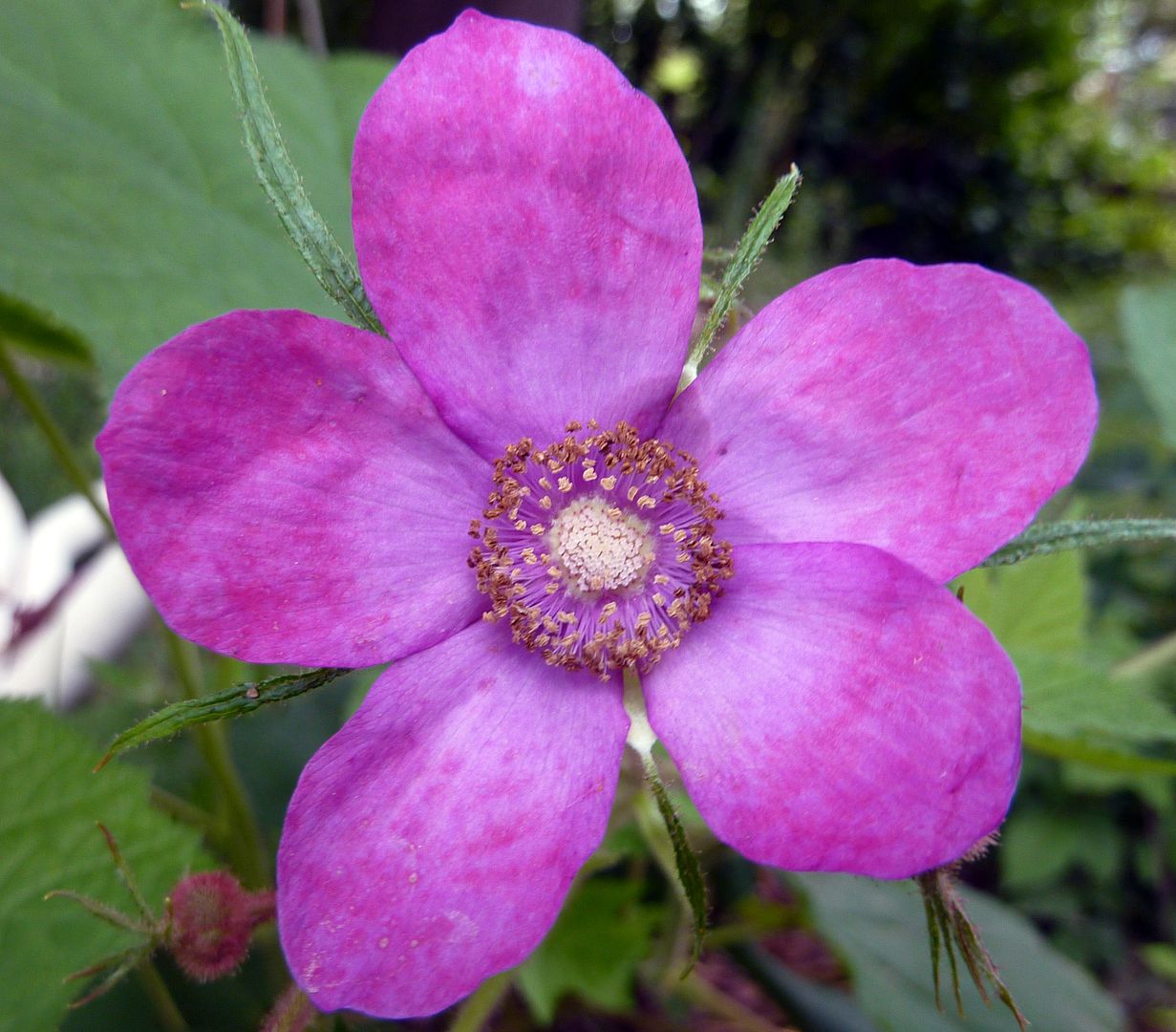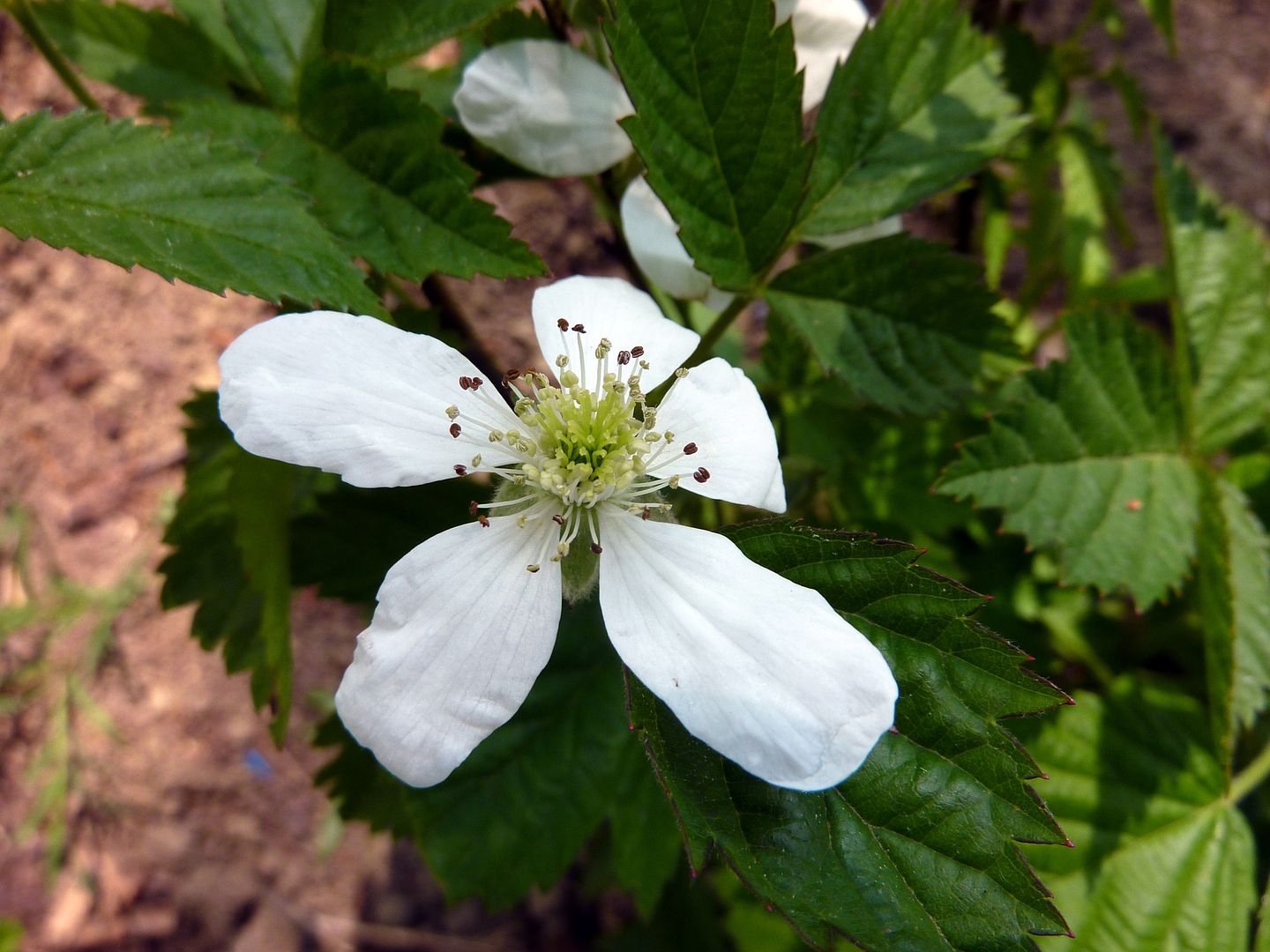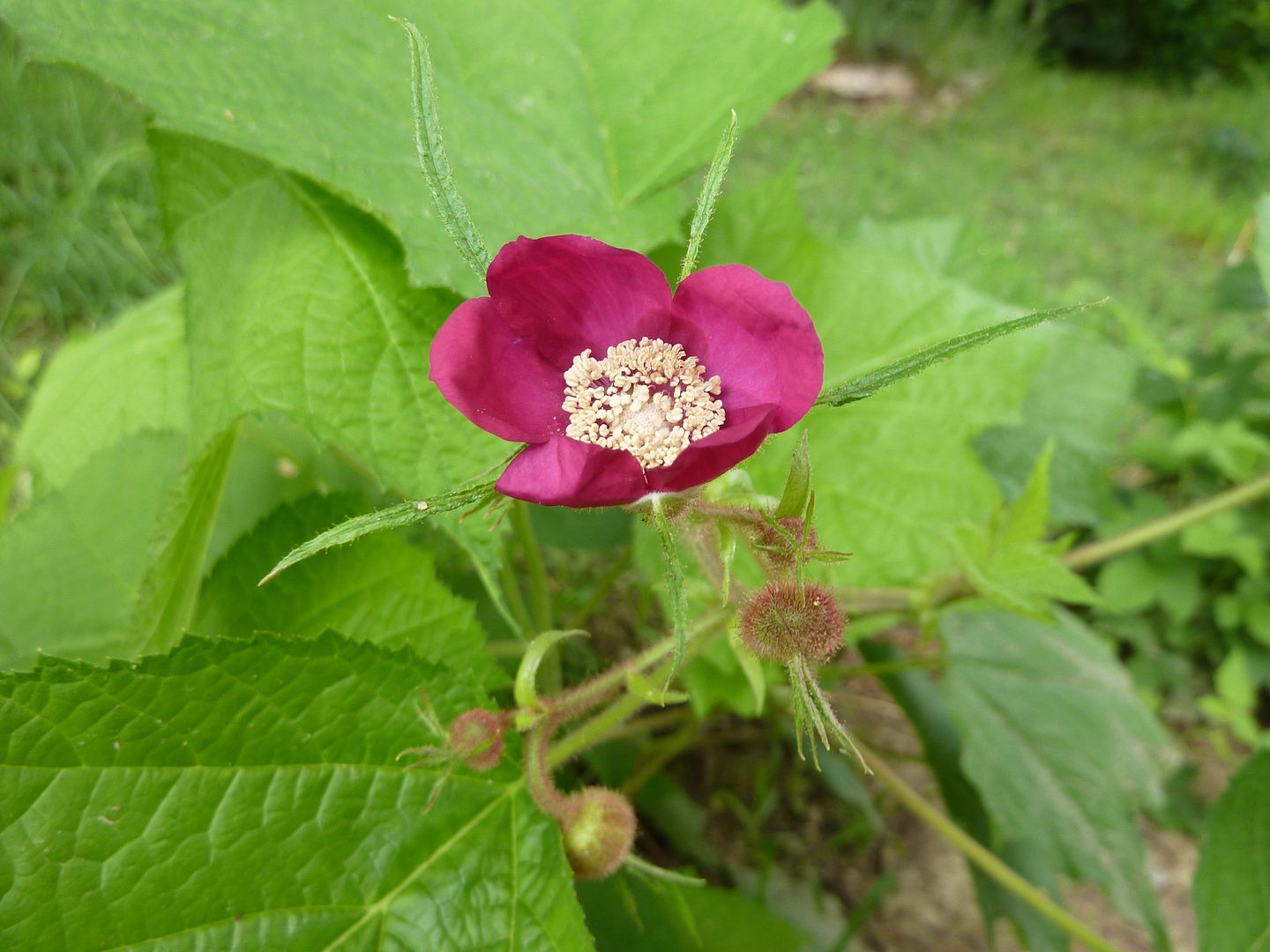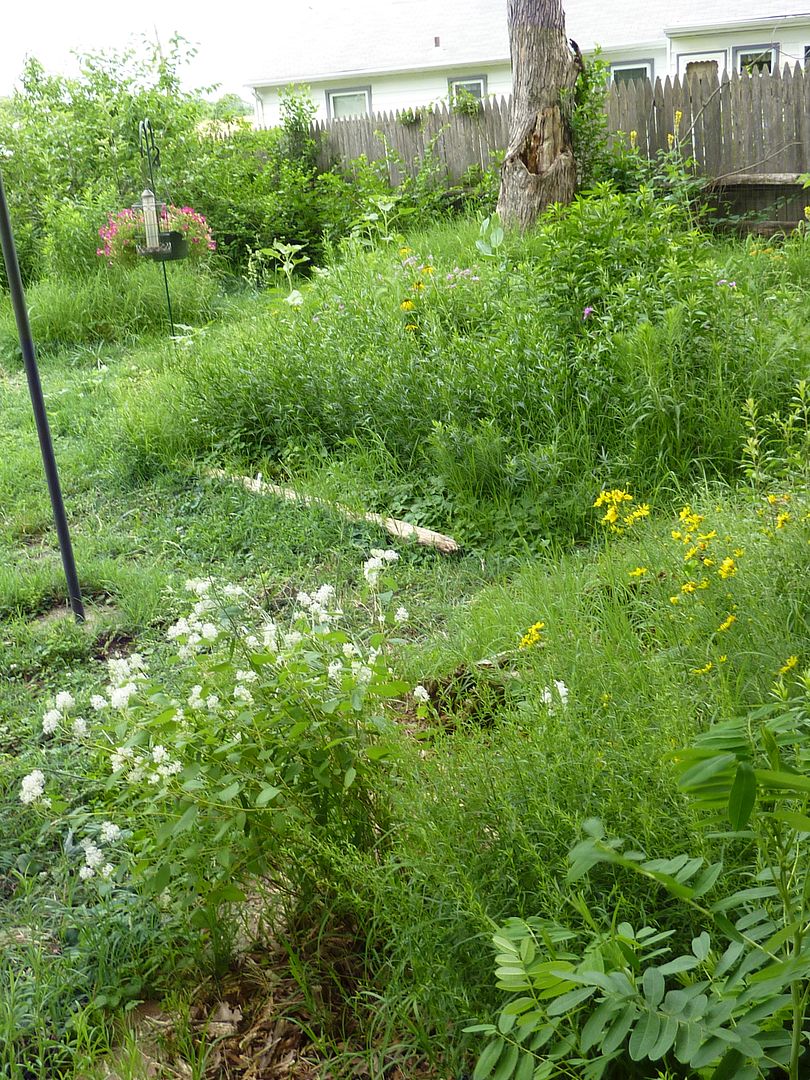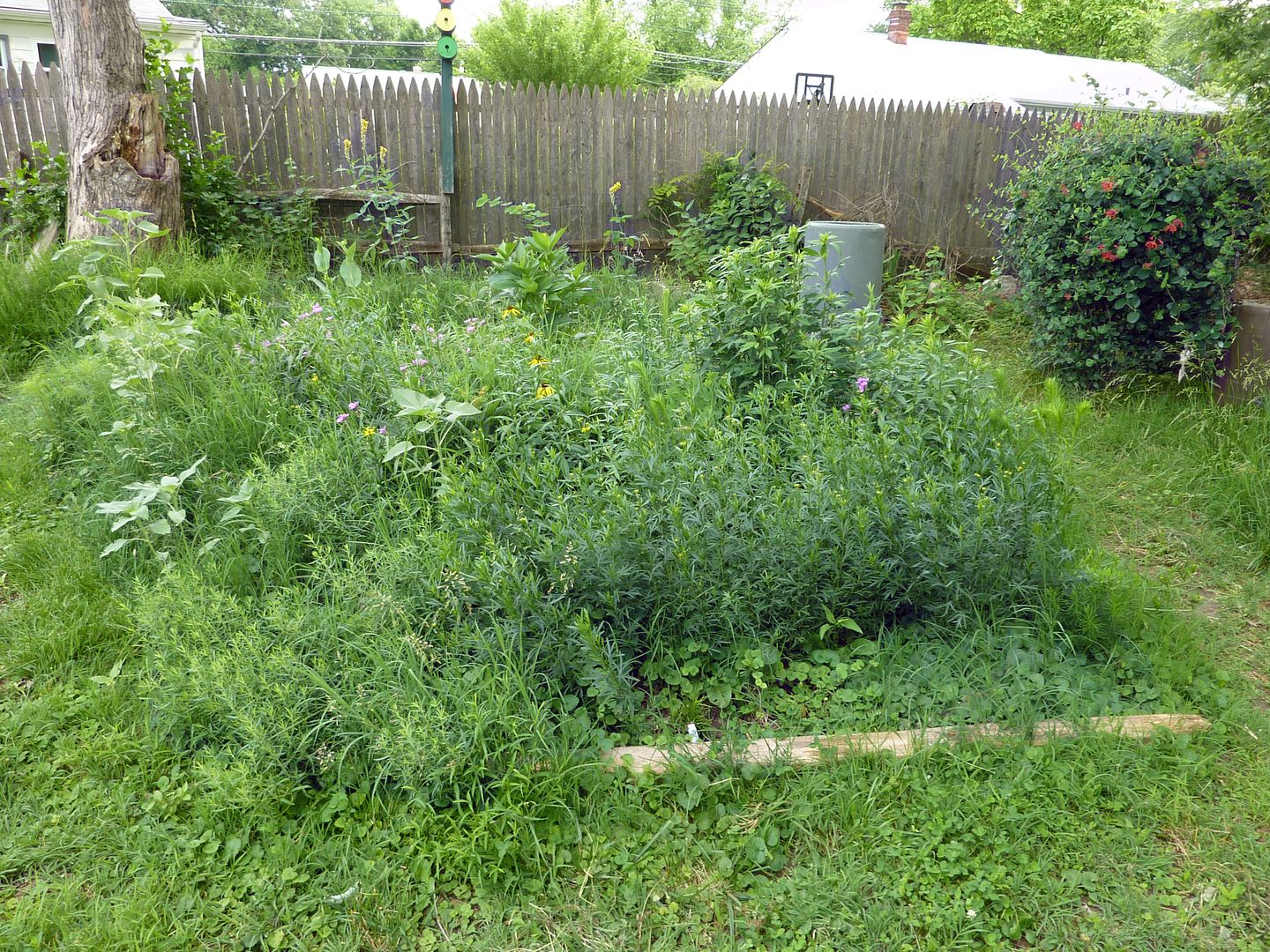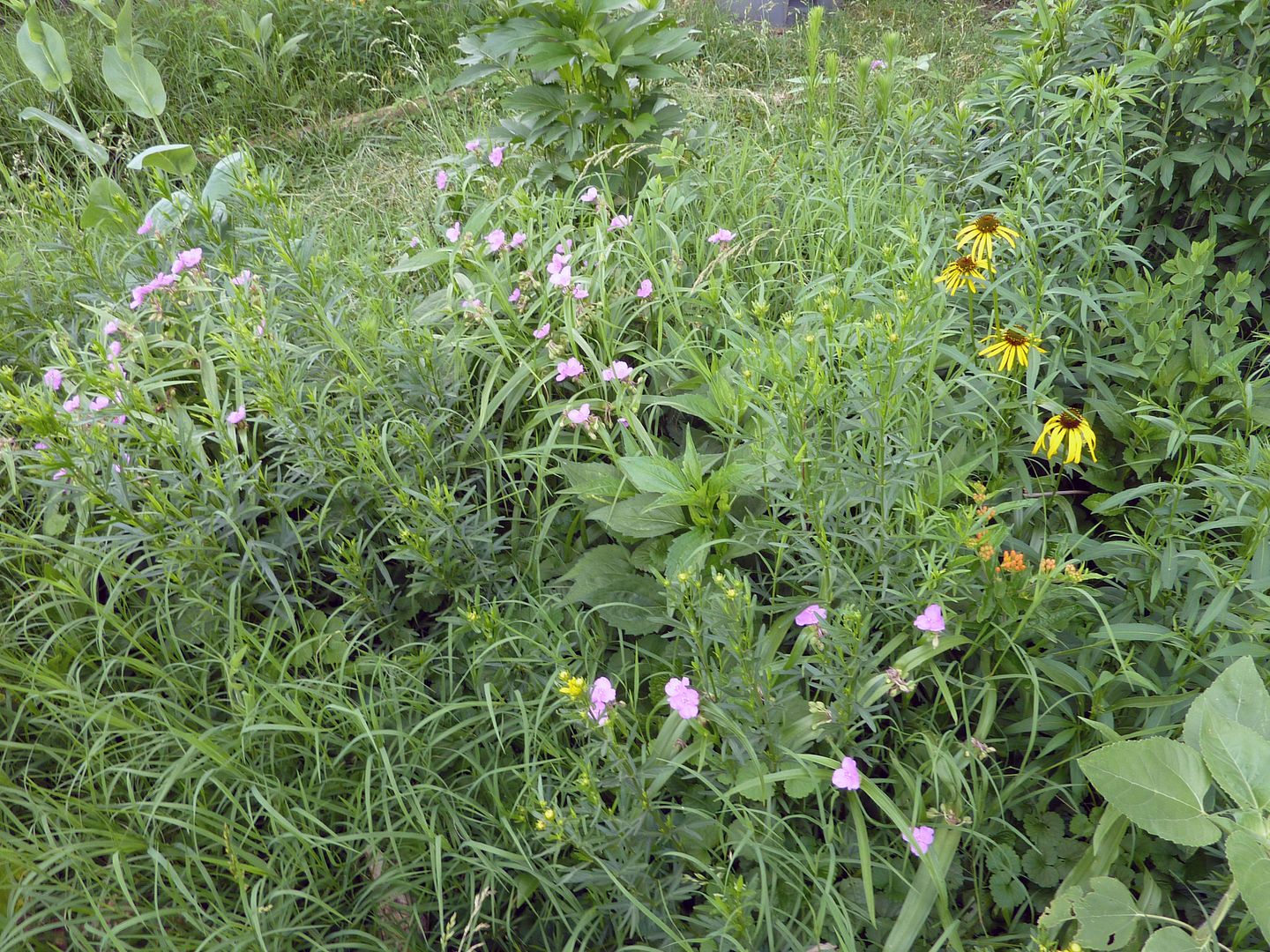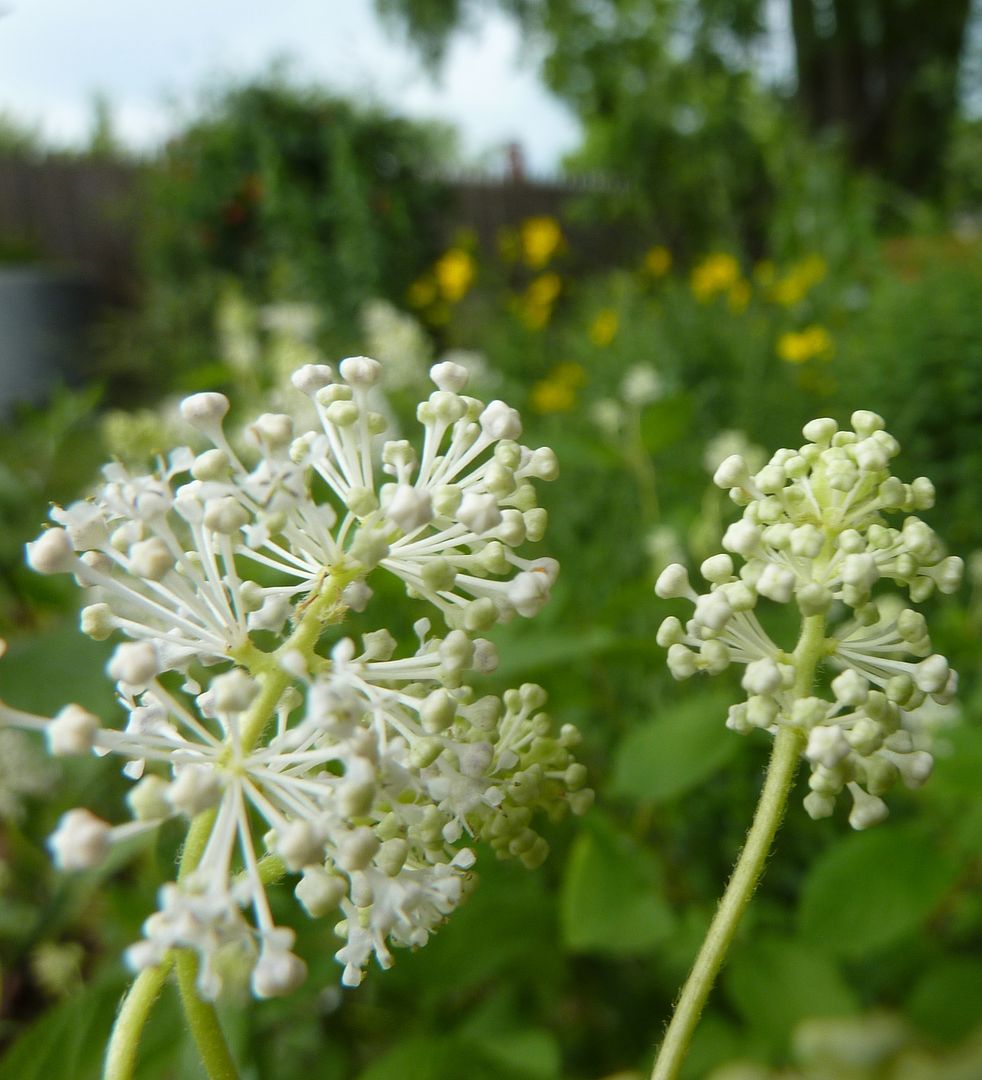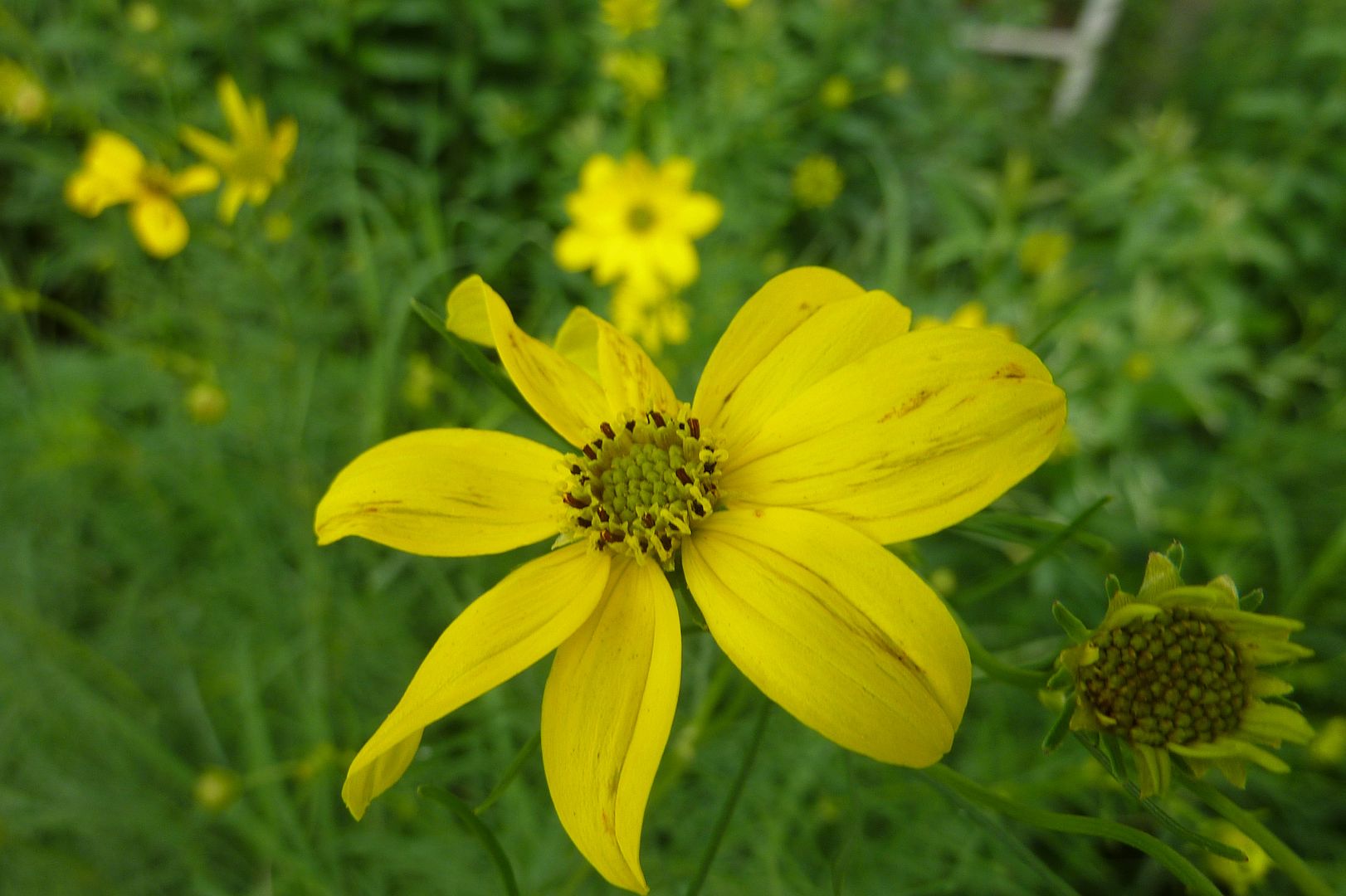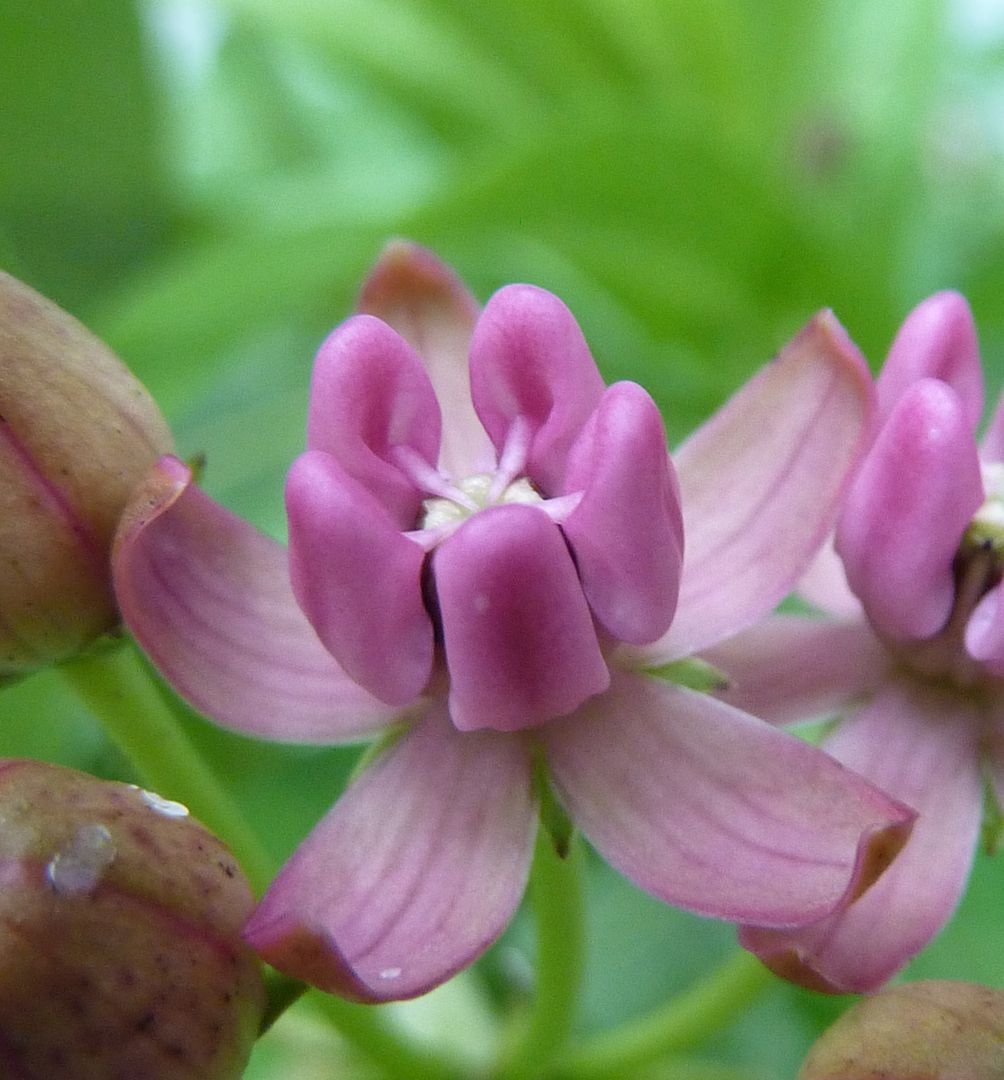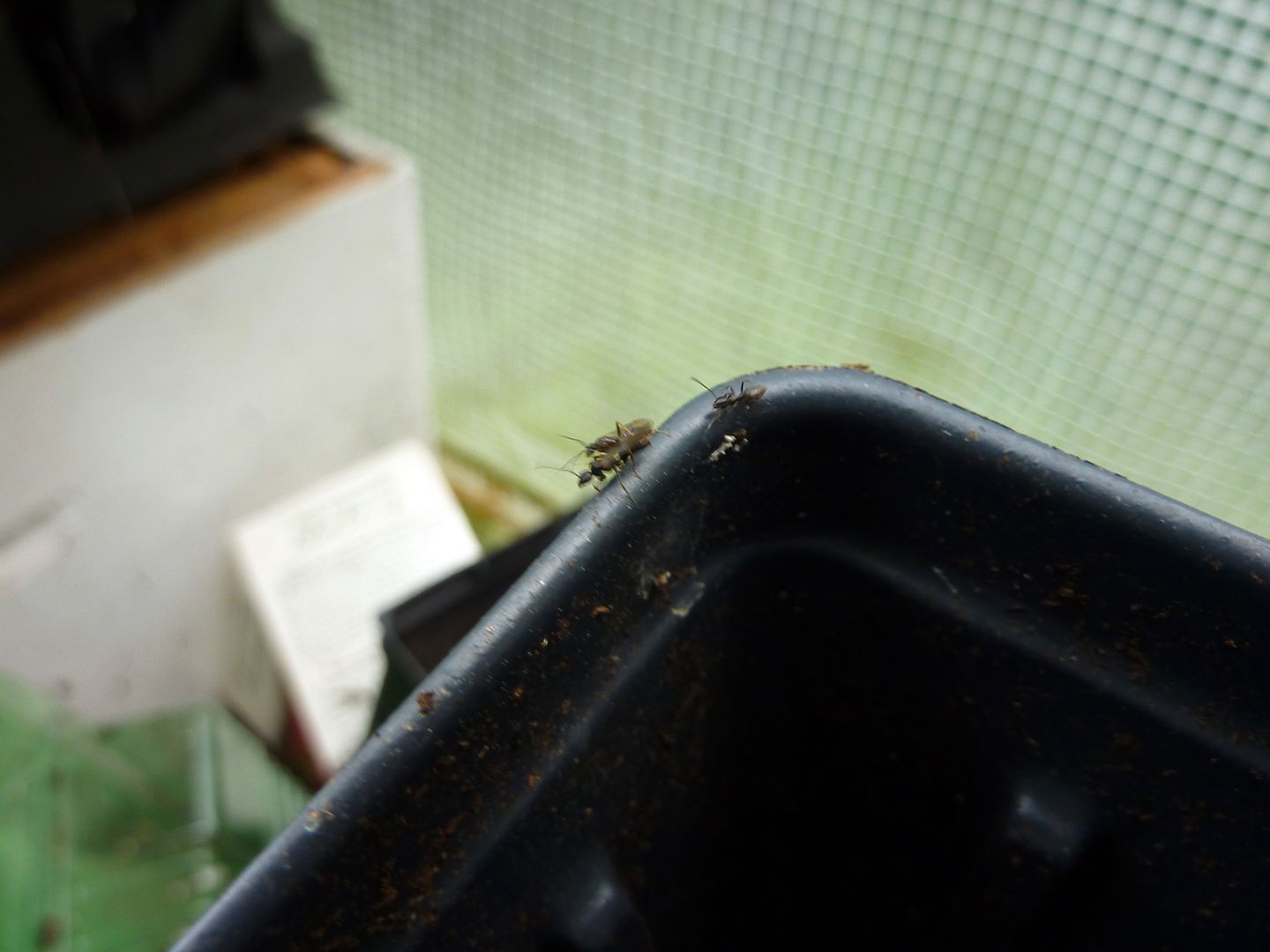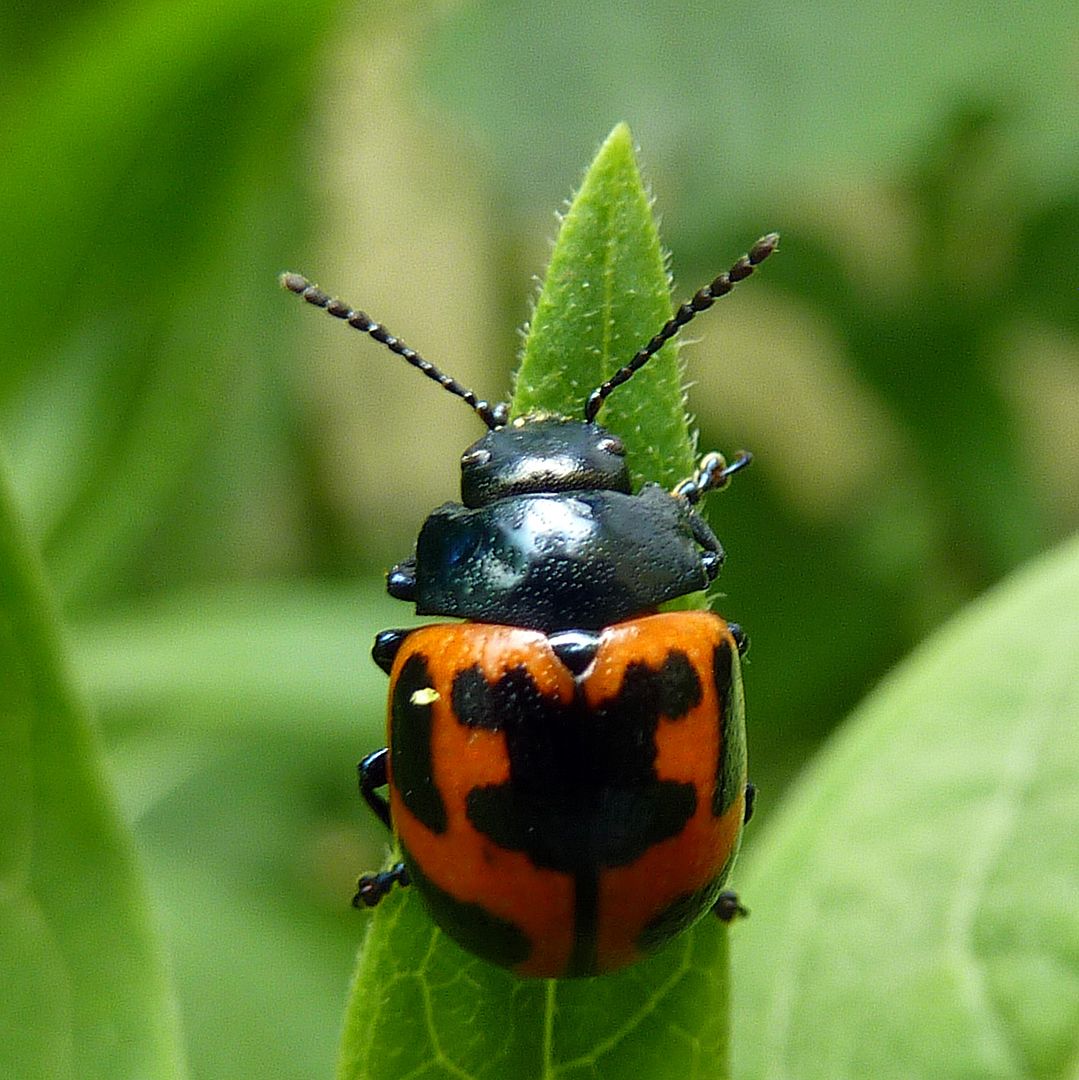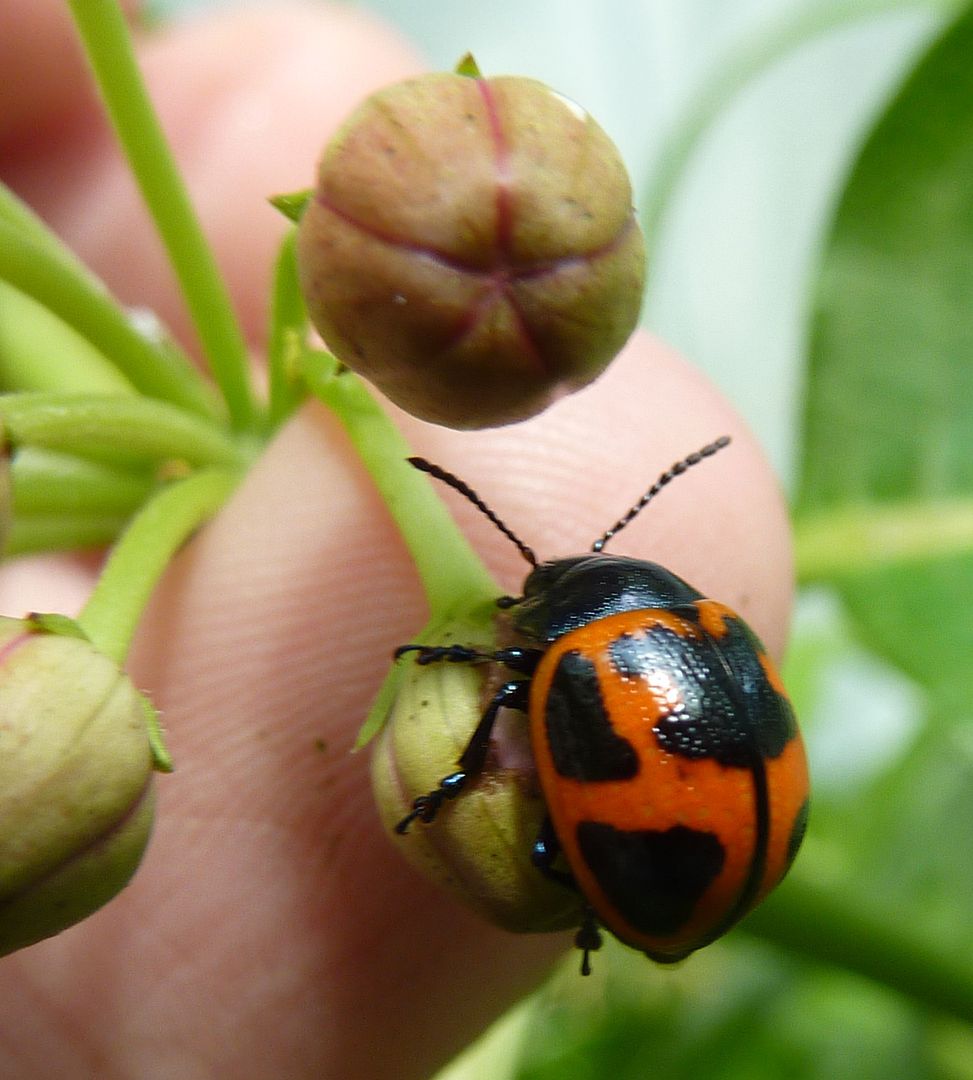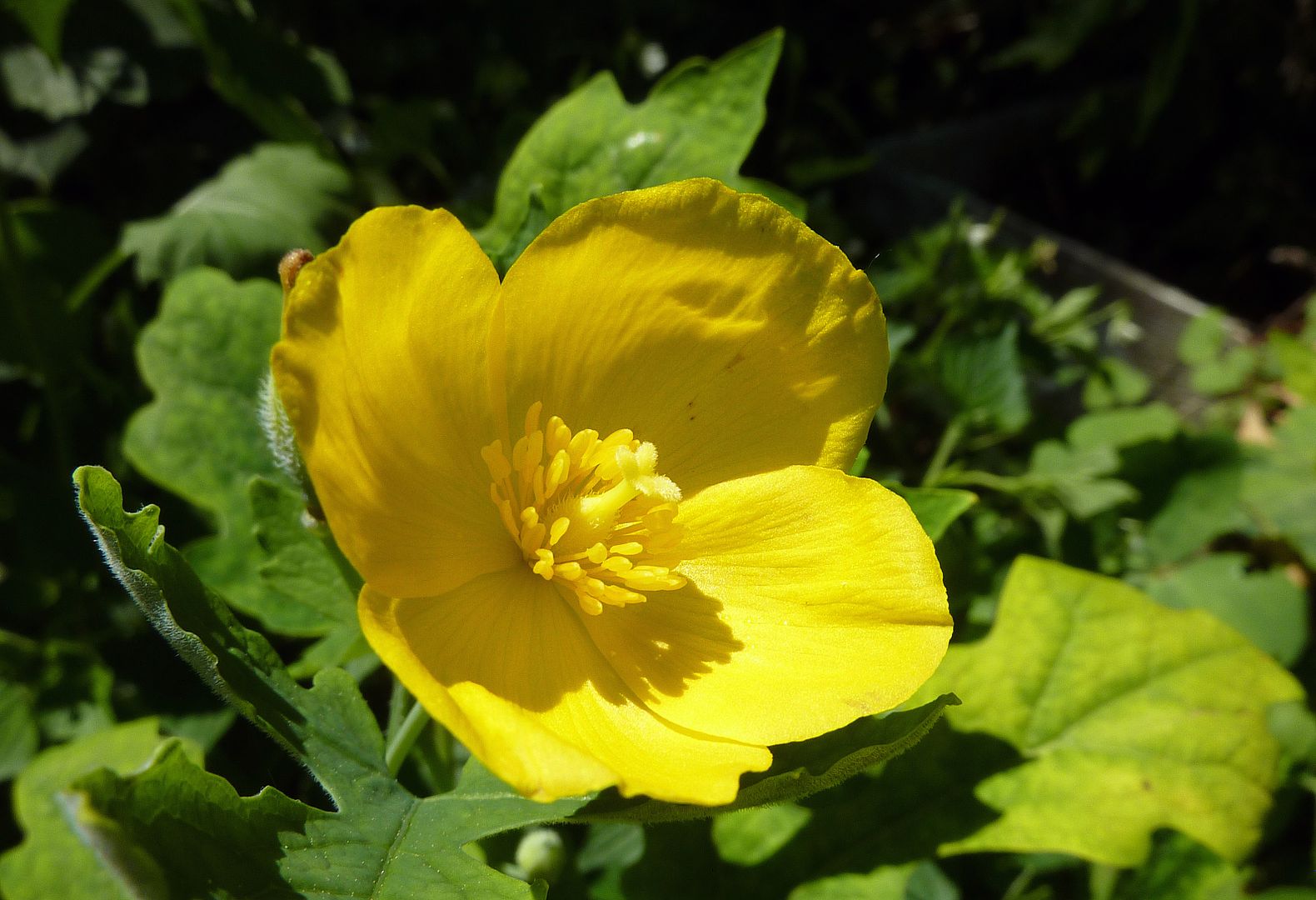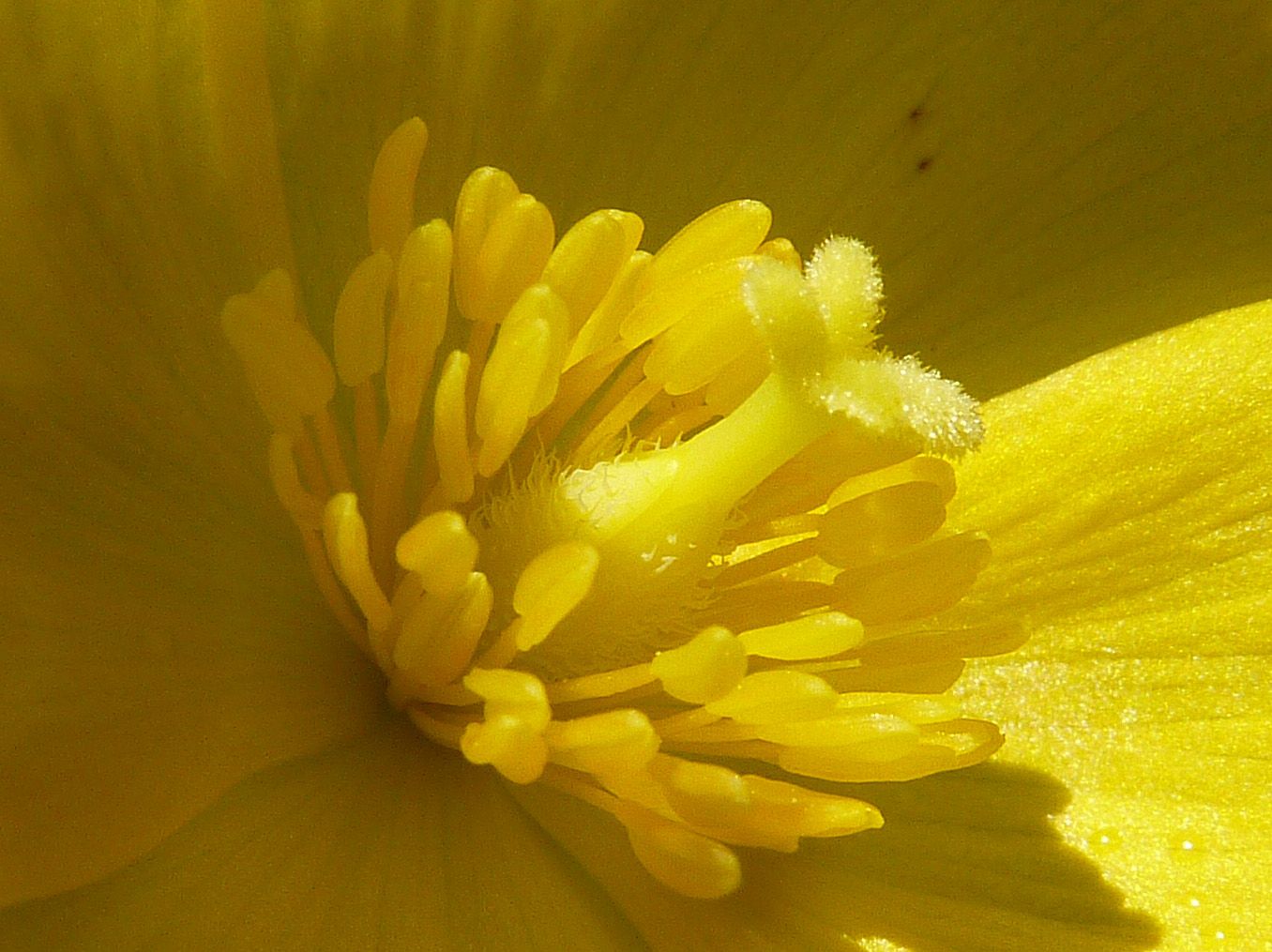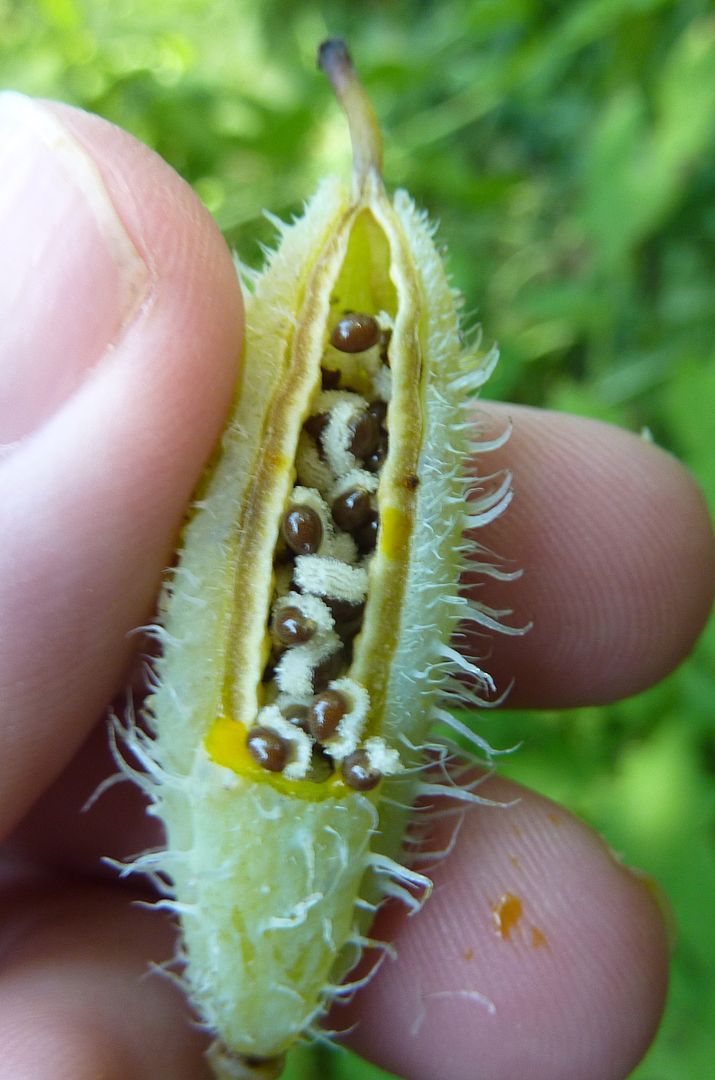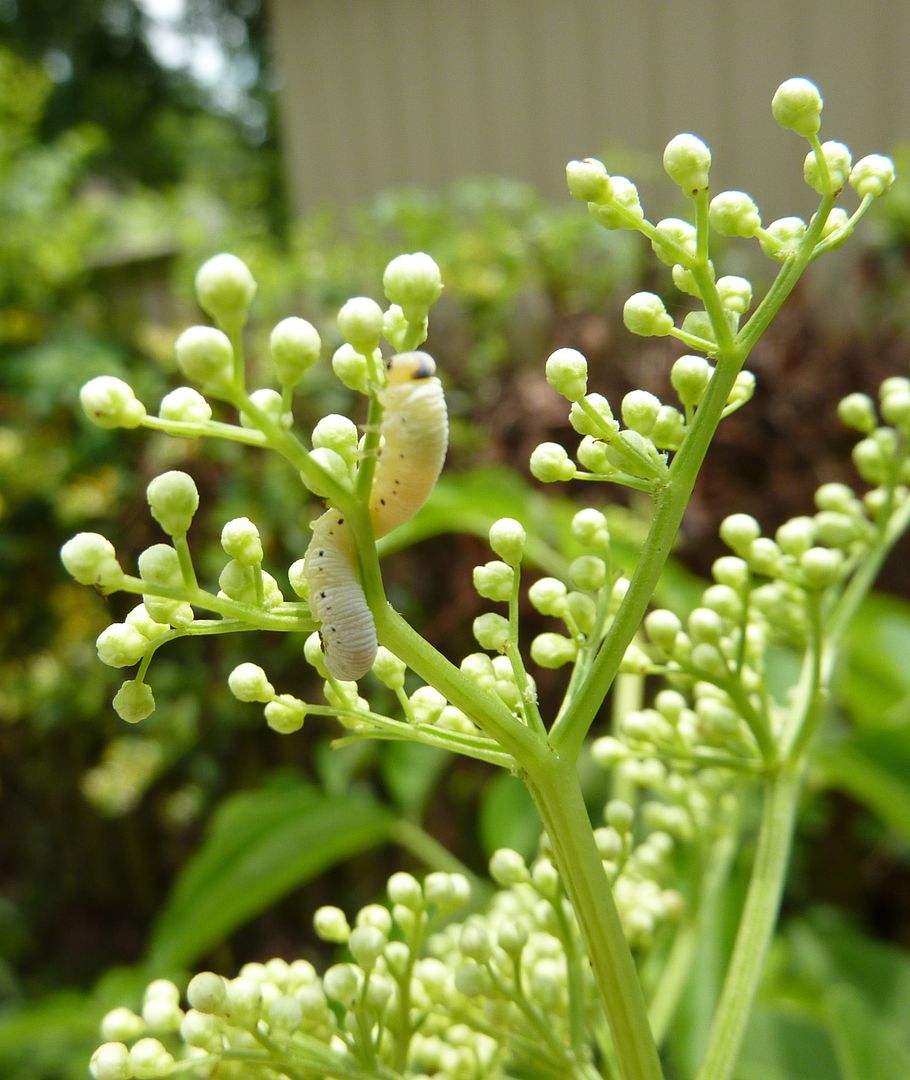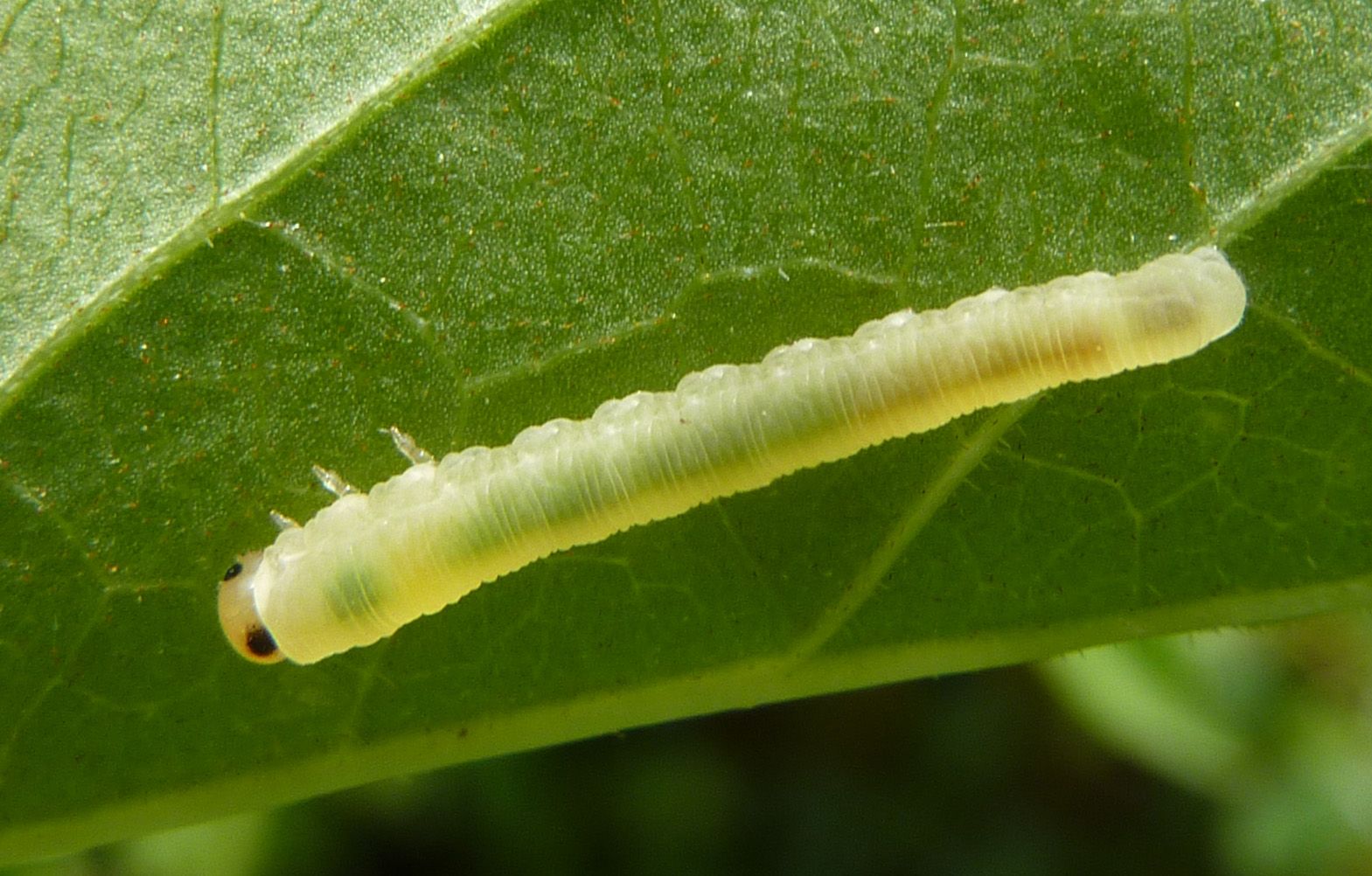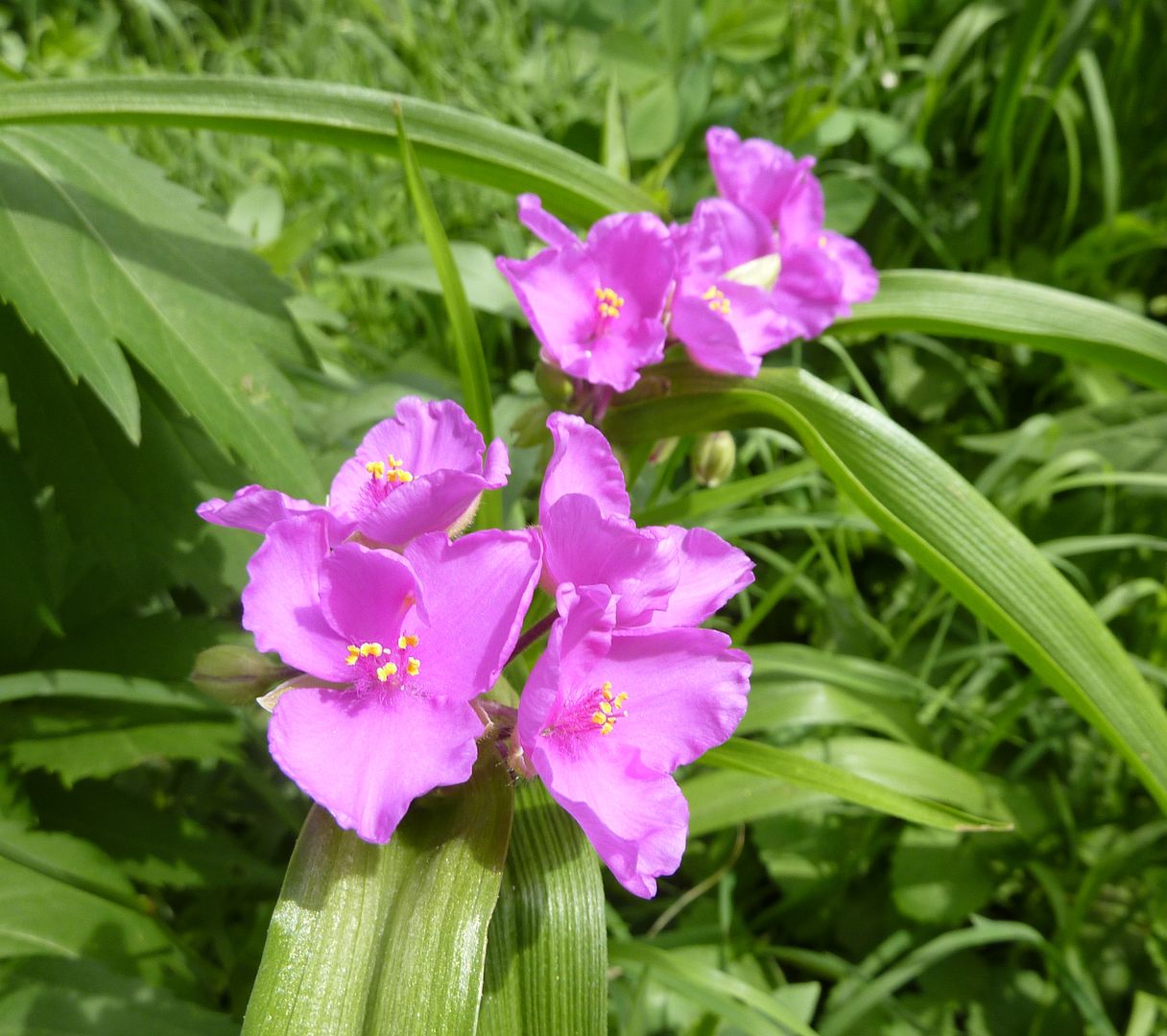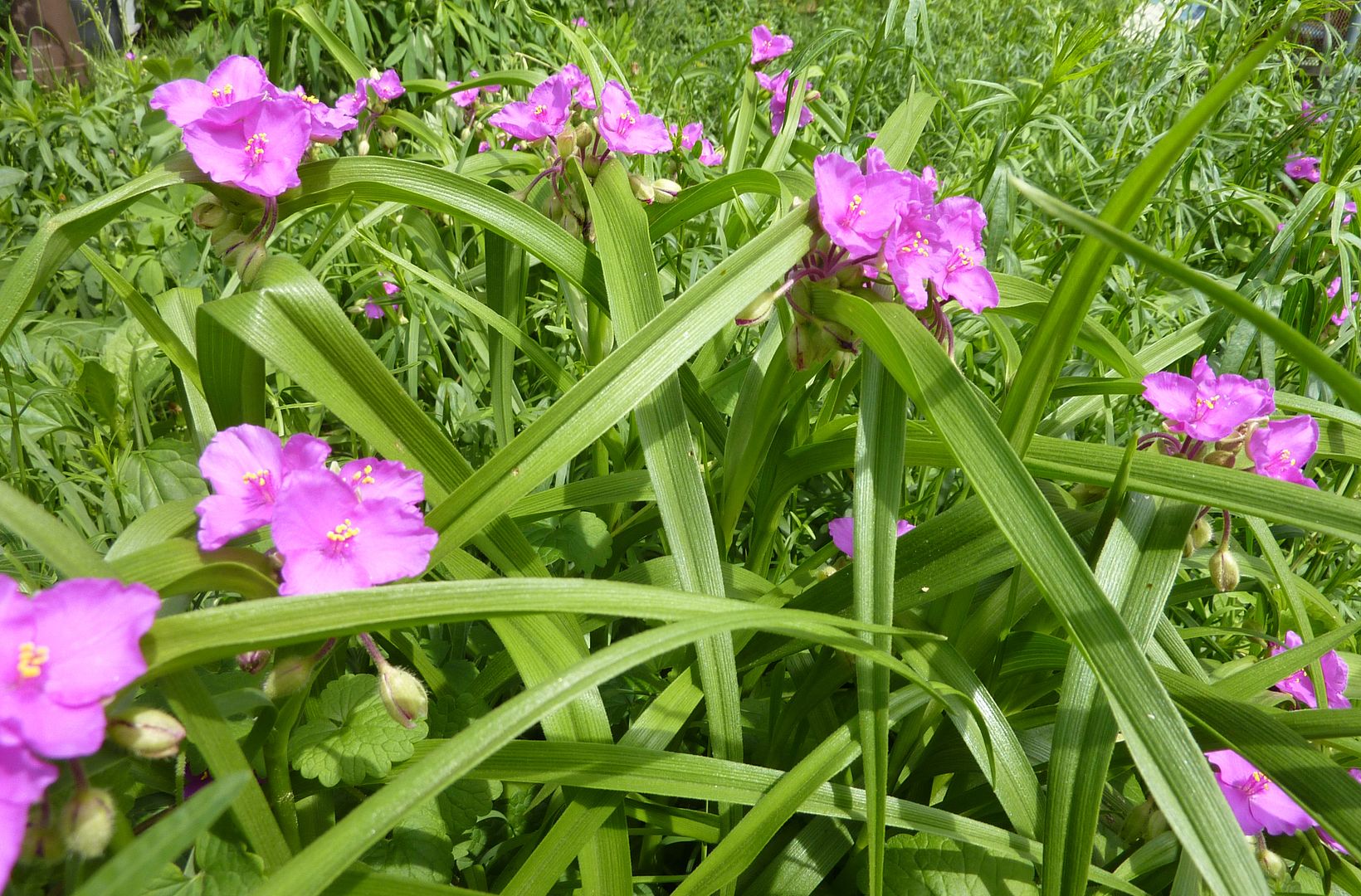Tall Bellflower is right!
Campanulastrum americanum, (Campanula americana? I guess the taxa was updated.)
This was a simple rosette of leaves last year that was barely four inches tall. I bought a seed pack of them from Prairie Moon Nursery. Of the seedlings I got 6 past the initial germination stage with many of the them dying. I eventually planted the survivors in the front garden, where for unknown reasons, only one of the six grew to be a rather big clump of leaves (like a Forget-Me-Not) while the others never really pushed out anything more after being planted.
After winter this one surviving plant was the only one to come back. And it quickly started to push up this massive stem which measures just over five feet at the end of June. It's probably not going to get much taller but also I wasn't expecting to be able to see it right out the window.
So the top third of the plant is mostly flower buds, along with a few off shoots and even a second main stem coming up from the roots. This plant should put on a pretty good show. I'm especially looking forward to getting a patch of them established and maybe letting them seed elsewhere in the yard. A plant that grows in dry shade isn't exactly common.
Their flowers are pretty but smaller than what I'd expected. Online photos had me thinking they'd be something like a daylily or smaller but these are barely an inch long. They're really boarder line what I'd call tiny and medium sized.
I've seen a few sweat bees buzzing about them to collect the pollen but nothing else seems to have working them yet. I'm holding off judgment until I see this thing in full bloom and even then what works them when I have like 5 or 12 plants all in bloom.
This isn't a plant I see a lot of native plant gardeners using, and I think once you get over that first year of establishing from seed, it's easy sailing from there. But I can't speak for subsequent years or if they're self pollinating or not.
Sunday, June 30, 2013
Saturday, June 29, 2013
Yellow Flowers
Between work and these thunderstorms we've been getting on a daily basis it's hard keeping up with everything that's flowering. Although the other issue might be that Yellow is probably the most over used color of our native wildflowers.
Whorled Coreopsis, C. verticillata, with what's been identified as a Banded Tussock Moth, Halysidota tessellaris, clinging to stay out of the rain to one of the flowers. The host plants to these are basically all the hardwood trees in the forest and the Willow-leaf Oak tree behind the garden was likely the host plant. The fun thing is I've actually found caterpillars of this species and not even realized it. They're basically white Woolly Bears with tufts of longer black hairs here and there.
Stiff Coreopsis, C. palmata, has really been kicking but these past few weeks. They're not forming a carpet of yellow but it's enough that I'm seeing bees work them on a daily basis now.
Annual Sunflower, Helianthus annuus, planted courtesy of messy birds at our bird feeder. I insist on only feeding them sunflowers because it's a native seed.
Prairie Coneflower, Ratibida pinnata, isn't a coneflower but close enough. They're not officially open yet but the petals are starting to push out and look nice on some of them.
Greater Coneflower, Rudbeckia maxima, also not officially open yet, and also not officially a coneflower but close enough. As it's in the Rudbeckia genus that makes it more closely related to the Black Eyed Susan, which is strange becuase they're 5' tall, have blue/gray foliage, and bloom earlier than any other Rudbeckia species at least in my garden.
Whorled Coreopsis, C. verticillata, with what's been identified as a Banded Tussock Moth, Halysidota tessellaris, clinging to stay out of the rain to one of the flowers. The host plants to these are basically all the hardwood trees in the forest and the Willow-leaf Oak tree behind the garden was likely the host plant. The fun thing is I've actually found caterpillars of this species and not even realized it. They're basically white Woolly Bears with tufts of longer black hairs here and there.
Stiff Coreopsis, C. palmata, has really been kicking but these past few weeks. They're not forming a carpet of yellow but it's enough that I'm seeing bees work them on a daily basis now.
Annual Sunflower, Helianthus annuus, planted courtesy of messy birds at our bird feeder. I insist on only feeding them sunflowers because it's a native seed.
Prairie Coneflower, Ratibida pinnata, isn't a coneflower but close enough. They're not officially open yet but the petals are starting to push out and look nice on some of them.
Greater Coneflower, Rudbeckia maxima, also not officially open yet, and also not officially a coneflower but close enough. As it's in the Rudbeckia genus that makes it more closely related to the Black Eyed Susan, which is strange becuase they're 5' tall, have blue/gray foliage, and bloom earlier than any other Rudbeckia species at least in my garden.
Friday, June 28, 2013
Red Milkweed
Asclepias rubra, Red Milkweed, is one of our rare native wildflowers that you almost never see sold anywhere. I found a nursery selling it, and yes, they propagate by seed. This picture was taken at night becuase I've worked most morning shifts for the past week, and come home to a plethora of storms, flood and tornado warnings. I'll try to post better images in the next few days.
Much like Asclepias purpurascens, Purple Milkweed, this species has a red vein down the middle of their leaves. The two species differ by Red Milkweed having much narrower leaves and typically paler flowers. As seen above flowers are more of a pinkish tone with paler almost white forms as well as darker sometimes bicolored forms too.
To add to this confusion I've noticed a few nurseries have started calling Swamp Milkweed, Asclepias incarnata, as Red Milkweed... they are wrong.
Much like Asclepias purpurascens, Purple Milkweed, this species has a red vein down the middle of their leaves. The two species differ by Red Milkweed having much narrower leaves and typically paler flowers. As seen above flowers are more of a pinkish tone with paler almost white forms as well as darker sometimes bicolored forms too.
To add to this confusion I've noticed a few nurseries have started calling Swamp Milkweed, Asclepias incarnata, as Red Milkweed... they are wrong.
Thursday, June 27, 2013
Butterfly Weed Relations
Asclepias tuberosa, Butterfly Weed, has been at the height of blooming for a week now. Here you can see the red stripes I talked a little about earlier. I may try to start a lot of this by seed this year and try to get some that has deeper red flowers. At any rate I plan on doing a lot of seed propagating this autumn to see what I can really get established.
Bumblebees have been the main pollinator of the flowers so there's little to worry about. This species is self compatable too so they'll generate viable seed even if they don't visit other plants.
Milkweed gets pollinated in an odd sort of way. Basically the pollen anthers themselves break off and attach to the foot of the pollinator, then then have to get stuck in one of the 5 grooves on another bloom.
Hidden among the flowers was awolf lynx spider (thanks Sara) which I saw had recently shed its skin.
Normally they're a gray color. What struck me about this one though was how it was almost mimicking the color of the milkweed flowers while its exoskeleton hardened up. I found several other spider skins attached to leaves under other plants.
My little meadow garden has been a good source of ant food for my Pheidole colony. The closest to a common name they have is Big-Headed Ants and while the major caste does have a large head it's not something the average person would notice. The ants are only 3mm long.
Bumblebees have been the main pollinator of the flowers so there's little to worry about. This species is self compatable too so they'll generate viable seed even if they don't visit other plants.
Milkweed gets pollinated in an odd sort of way. Basically the pollen anthers themselves break off and attach to the foot of the pollinator, then then have to get stuck in one of the 5 grooves on another bloom.
Hidden among the flowers was a
Normally they're a gray color. What struck me about this one though was how it was almost mimicking the color of the milkweed flowers while its exoskeleton hardened up. I found several other spider skins attached to leaves under other plants.
My little meadow garden has been a good source of ant food for my Pheidole colony. The closest to a common name they have is Big-Headed Ants and while the major caste does have a large head it's not something the average person would notice. The ants are only 3mm long.
Wednesday, June 26, 2013
Butterfly Weed in Bloom
Butterfly Weed, Asclepias tuberosa, gets its name from the fact that butterflies like it... and it's a weed? Okay this is why common names suck; labels at any garden center will have you think all plants attract butterflies, and calling something a weed is subjective. In the right setting butterflies will flock to this plant but so far we're having an off year for butterflies.
This particular species is most often found with orange flowers, but there's also a yellow form and one with deeper red vanes. Although I grow both yellow and orange forms, this one pictured above is a seedling that's come up on it's own.
This is a brilliant care free plant for dry sunny places and once established they won't need watering at all. In fact it's been reported this plant will stay lush and green even after grasses have gone brown and dormant around it.
The red vane doesn't always occur on the flowers, but I've seen some patches that had more red to them than orange. This doesn't seem to be common at all and I wish I had some to show what I'm talking about.
This particular species is most often found with orange flowers, but there's also a yellow form and one with deeper red vanes. Although I grow both yellow and orange forms, this one pictured above is a seedling that's come up on it's own.
This is a brilliant care free plant for dry sunny places and once established they won't need watering at all. In fact it's been reported this plant will stay lush and green even after grasses have gone brown and dormant around it.
The red vane doesn't always occur on the flowers, but I've seen some patches that had more red to them than orange. This doesn't seem to be common at all and I wish I had some to show what I'm talking about.
Monday, June 24, 2013
Purple Flowering Raspberry and Dewberry
It opened! And it also stormed last night so that fluffy pollen filled appearance went a little down hill. Also the petals faded up a bit quicker than I'd expected. It's still pretty and I'm looking forward to seeing lots more of them.
Another plant in this genus I've tried is Common Dewberry, Rubus flagellaris. This is basically a low growing blackberry that grows more as a bramble along the ground. Their fruiting stems come up to about 4' but the longer ones that spread out can grow to be 15' long! This flowered about a month ago, and it's just produced a few berries. They're tart but sweeter than the actual blackberries I grow. Meaning you don't really need to eat them with heavy cram or anything. They're still super tart so it's always an option but they're bearable to eat right off the vine.
Another plant in this genus I've tried is Common Dewberry, Rubus flagellaris. This is basically a low growing blackberry that grows more as a bramble along the ground. Their fruiting stems come up to about 4' but the longer ones that spread out can grow to be 15' long! This flowered about a month ago, and it's just produced a few berries. They're tart but sweeter than the actual blackberries I grow. Meaning you don't really need to eat them with heavy cram or anything. They're still super tart so it's always an option but they're bearable to eat right off the vine.
Sunday, June 23, 2013
Purple Flowering Raspberry
Open Faster!!!
So this little jewel started to peek open this morning and I've never wanted a flower to open up faster before in my life. This is Purple
Flowering Raspberry, Rudus odoratus. Along with looking like one of our native roses, this plant lack prickers or thorns as found on typical Raspberries and instead has sticky hairs which are sort of neat to touch. Their pollen filled flowers go on to produce edible fruit that I've read taste as good as if not slightly less than traditional red Raspberries. Honestly though it might be a sacrifice I can live with if I could get a row of these beauties in my yard every year. Why isn't this plant more widely sold? Or at least crossed so the red raspberry produces a prettier flower?
Sunday, June 16, 2013
My Meadow Garden
Being the compulsive plant shopper that I am, I'm so thrilled with the way the meadow garden has turned out this year. I started this project back in 2011, and they say it takes three year before a meadow really takes off. What's odd though is they say that about meadows started by seed because nothing really flowers until year two or three and then some don't flower until year seven or beyond. Meadows otherwise look like a bunch of weeds their first, and sometimes second year.
Another reason seeds wouldn't have worked was that my lawn is basically made up of crab grass, which my dad "thinks" he may have planted on purpose years ago becuase it naturally spreads by runners and fills in an area. His theory being that this would lead to a nice thick lawn. While many lawn grasses do this, this crab grass in particular is the most annoying plant I've ever had to deal with. Along the roots it produces corms that are thorn shaped thus pulling them out of the ground often results in me being stabbed and pricked in uncomfortable ways.
To it's benefit though, it does fill in, my meadow is lacking grasses, and it basically marks where I haven't planted things yet.
So here's a short list of what's blooming now.
New Jersey Tea, Ceanothus americanus, which is actually a low 3' tall shrub that's covered in little white puffs of flowers. This is the only plant I need to remember not to mow over with the lawn mower each year and it's bright yellow stems really make it stand out. It's often praised as a good hummingbird plant, not because of the flowers, but because of the swarms of tiny bugs that go for the flowers. It's taken three years but sure enough I'm starting to see in the late afternoon this plant is bustling with tiny gnat-like insects. I haven't seen hummingbirds going for them yet but I'm sure it's only a matter of time. During the hotter times of the day nonsocial wasps tend to pollinate it. These types of wasps are beneficial because they're often specialized predators or parasites of beetle grubs, spiders, and caterpillars.
Whorled or Thread-leaf Coreopsis, Coreopsis verticillata, is growing right behind it. It doesn't get that much attention but I'm sure that may change in a few years. This started out as one plant, that is to say one stem that grew up to about 3' tall and produced maybe four flowers in it's first year. It's since reseeded in a non-aggressive way onto adjacent bare soil. This was the first of my native plants that I realized was not only growing happily but also self seeding around. Before then there had been this fear that maybe I'll rip up the lawn, plant everything, but only to watch it all die out slowly over the next ten years. This plant cured me of that fear.
Butterfly Weed, Asclepias tuberosa, these flowers are now open but I thought it was a neat shot. This is the host plant to the Monarch Butterfly among a few other things we don't hear enough about. Drought tolerant, loves growing in dry locations, and boasts brilliant orange flowers.
Ozark Coneflower, Echinacea paradoxa, this was a surprise this year because I'd planted this species a year or two ago and it died out. Coneflowers have never done well in my meadow and I'm not sure why that is. So this year I ordered Pale Purple Coneflower, Echinacea pallida, to give that species a try. Well what arrived grew better than anything had before, and when I saw the flower buds I was thrilled... but then the petals were yellow! So so one of the nurseries I ordered Pale Purple Coneflowers had mix up and they'd sent me Ozark Coneflower instead.
I'm not complaining. These plants seem to be a lot healthier than the first batch of Ozark Coneflowers I tried years ago. I initially wanted that species because the yellow went so well with the orange Butterfly Weed. We'll see if these are better able to establish.
Thursday, June 13, 2013
Purple Milkweed Flowers
Purple Milkweed, Asclepias purpurascens, has finally started flowering! I've been growing this plant for three years and finally it blooms! I initially bought three of them, of which only one survived. As it turns out this species is a little finicky to grow. This one is growing in partial sun/mostly shade in ....uhh average, leaning more toward damp, soil. I have tried to start this plant from seed, which germinated, and I then planted them all over, only to have them all die over the winter time. I don't know what it is about this one plant or this one spot but I'm happy it's thriving. That said, this milkweed species isn't self compatable, so it will never pollinate itself and won't produce seeds until I manage to get another one established and flowering.
No sooner does it start blooming, that Odorous House Ants, Tapinoma sessile, start raiding the flowers for nectar. I've noted how this ant species seems to specialize in robbing nectar from flowers in the past, and I'm quite annoyed they've chosen this plant to steal from. The flowers to Purple Milkweed are actually larger than those of Asclepias tuberosa. I've never seen these ants going nuts like this over milkweed flowers. Usually it's just a few workers, but this plant at times had almost five ants per flower! It suggests to me that this species produces a higher quality of nectar more deserving of insects that may actually pollinate it.
No sooner does it start blooming, that Odorous House Ants, Tapinoma sessile, start raiding the flowers for nectar. I've noted how this ant species seems to specialize in robbing nectar from flowers in the past, and I'm quite annoyed they've chosen this plant to steal from. The flowers to Purple Milkweed are actually larger than those of Asclepias tuberosa. I've never seen these ants going nuts like this over milkweed flowers. Usually it's just a few workers, but this plant at times had almost five ants per flower! It suggests to me that this species produces a higher quality of nectar more deserving of insects that may actually pollinate it.
Ants Swarming in My Green House
After all this rain we've been getting, I went out to the green house to find a nuptial flight of Odorous House Ants, Tapinoma sessile, trying to take off.
Queens are only a hair bigger than the workers. This ant is a minor annoyance in homes, despite being a native species. Colonies often have multiple queens, and divide as needed. It's been noted that colonies are enormous in urban settings, sometimes taking up several city blocks, while suburban and rural settings yield much smaller colonies, often only a few thousand ants.
Despite their name, Odorous House Ant, they are only odorous if squished, and can be discouraged out of homes simply by sealing up holes they happen to be coming in through. This is sometimes easier said than done. They're opportunistic nesting and find the hollow space behind a loose kitchen back splash very appealing. Resorting to baits might be called for if they're out staying their welcome.
Out in the green house they nest right the flats to my plants as well as the loose space inside of pots along the outer edge of the soil. I'm certain I've divided this colony a few times simply by planting seedlings out in the garden.
I've also been noticing termite alates flying out and about in the yard. The Robins in particular are enjoying them.
Tuesday, June 11, 2013
Swamp Milkweed Leaf Beetle
The Swamp Milkweed Leaf Beetle, Labidomera clivicollis, is one of many colorful insects associated with milkweed. The orange and black coloration is almost universal signs that says "Don't Eat Me" or "I Taste Awful." The Monarch Butterfly, Milkweed Bugs, the Four Eyed Beetle and even the Milkweed Tussock Moth and Caterpillar all use this color pattern. Down South "Queen" and "Soldier" Butterflies are as brilliantly orange and black as the Monarch. There are even species that mimic these to not get eaten, such as the Viceroy which differs from the Monarch in that it's wings are smiling among other things.
Unfortunately this Swamp Milkweed Beetle has a liking for Purple Milkweed, Asclepias purpurascens, which is going to flower for the first time in my yard. Worst of all, it has a liking for eating the flower buds instead of the leaves. So I've moved it over to some Asclepias incarnata which is the species the beetle is named after. They also go for Common Milkweed, Asclepias syriaca, and likely others as well.
Unfortunately this Swamp Milkweed Beetle has a liking for Purple Milkweed, Asclepias purpurascens, which is going to flower for the first time in my yard. Worst of all, it has a liking for eating the flower buds instead of the leaves. So I've moved it over to some Asclepias incarnata which is the species the beetle is named after. They also go for Common Milkweed, Asclepias syriaca, and likely others as well.
Friday, June 7, 2013
Better Late Than Never
So in the midst of a flood warning on a day that's forecast to be nothing but rain, I come home to find my green house flooded at least four inches and rising, I then discover that the last Black Swallowtail decided to emerge...
Assuming there's clear skies in the morning, I'll be releasing her into the meadow.
Assuming there's clear skies in the morning, I'll be releasing her into the meadow.
Thursday, June 6, 2013
Spring Wildflowers Fade Away
The heat of June has started to set in and all our ephemerals are finishing up their show. The Eastern Red Columbine in the front garden looks as amazing as ever. This plant started as just a plug I bought one year and has since seeded itself all over in the tamest way possible. It filled out the garden I planted it initially and despite me spreading seeds all over other gardens, it only ever comes up in inhospitable places, such as in old flower pots I have stacked up and don't water. This year I think I'll try spreading them in a flat out in the green house to see if they'll grow.
Flame Azalea, Rhododendron calendulaceum, gave me a wonderful week of fragrant yellow flowers. It doesn't flower as well as I'd like it to but I'm chocking that up to it still establishing some.
Blue False Indigo, Baptisia australis, has been showing off some nice columns of flowers this year. I've learned a few things about this plant this year. (1) They can be divided, if they shoot is old enough to flower, then it's old enough to be separated from the rest of the plant with a good sharp shovel. (2) They can be an okay cut flower, which was surprising to me. I don't recommend it becuase pollinating doesn't always happen well with these and seedling production should be promoted. But sometimes you find a color combination or hybrid you really really like, so dividing and propagating that way can allow you to keep some interesting results.
Lastly I discovered a Woodland Poppy that's still pushing out flowers, Stylophorum diphyllum. Most of these have finished up for the year, but I'm happy seeing this one still going.
Close up of the flower.
The earliest seed pods to this species have started to pop open, and I'm finding them full of ants who are too eager to eat the elaiosome from the seeds. I'm starting to find this wildflower growing out from under rocks and logs too, generally places where ants nest. This is another wildflower I'm going to try growing in flats this year, though I think they might require a cold period to germinate.
Flame Azalea, Rhododendron calendulaceum, gave me a wonderful week of fragrant yellow flowers. It doesn't flower as well as I'd like it to but I'm chocking that up to it still establishing some.
Blue False Indigo, Baptisia australis, has been showing off some nice columns of flowers this year. I've learned a few things about this plant this year. (1) They can be divided, if they shoot is old enough to flower, then it's old enough to be separated from the rest of the plant with a good sharp shovel. (2) They can be an okay cut flower, which was surprising to me. I don't recommend it becuase pollinating doesn't always happen well with these and seedling production should be promoted. But sometimes you find a color combination or hybrid you really really like, so dividing and propagating that way can allow you to keep some interesting results.
Lastly I discovered a Woodland Poppy that's still pushing out flowers, Stylophorum diphyllum. Most of these have finished up for the year, but I'm happy seeing this one still going.
Close up of the flower.
The earliest seed pods to this species have started to pop open, and I'm finding them full of ants who are too eager to eat the elaiosome from the seeds. I'm starting to find this wildflower growing out from under rocks and logs too, generally places where ants nest. This is another wildflower I'm going to try growing in flats this year, though I think they might require a cold period to germinate.
American Persimmon Take Two
So this is the second year my wild persimmon tree has flowered. Diospyros virginiana is our native species which normally requires two trees for pollination but I have a cultivar called 'Meader' which can self pollinate. This is a desirable trait becuase our native persimmon can turn into a 60' tall tree, though I rarely see them that big. Last year it did produce fruit but unfortunately hurricane Sandy had other plans and there was not a fruit to be had on the tree. (All things considered we were lucky.)
I've found our native Carpenter Bees like to pollinate them. Unfortunately some grass is blocking the picture but this demonstrates how they like to flower on semi-old wood. All the new stems pushing out this year don't have any flowers on them.
Persimmons are a very odd fruit, shaped like tomatoes, orange like pumpkins, and they taste sort of like cantaloupe (musk melon) once you get past the astringent aspects. Storing them in the freezer for a day removes the unpleasant taste. What's neat is that the fruit usually clings to the tree even after the leaves have fallen off in the autumn.
Now if only my Paw Paws would get their act together.
I've found our native Carpenter Bees like to pollinate them. Unfortunately some grass is blocking the picture but this demonstrates how they like to flower on semi-old wood. All the new stems pushing out this year don't have any flowers on them.
Persimmons are a very odd fruit, shaped like tomatoes, orange like pumpkins, and they taste sort of like cantaloupe (musk melon) once you get past the astringent aspects. Storing them in the freezer for a day removes the unpleasant taste. What's neat is that the fruit usually clings to the tree even after the leaves have fallen off in the autumn.
Now if only my Paw Paws would get their act together.
Monday, June 3, 2013
Some Sawfly on my Elderberry
Much to my delight, the Elderberry I got last autumn is going to flower, and has also attracted some attention from mother nature. Taxonomy on sawflies doesn't seem to be all that perfect so I'm left to conclude this little worm to be a Macrophya species.
Sawflies are the odd cousins of the Hymenopter order (Ants, Bees, and Wasps) who have a caterpillar-like larval stage that even feeds on host plants, though some are parasites on beetle larva. The adults are wasp like in appearance and it's this unusual larval stage among a few other things that separates them from wasps.
It's just the two larva that I saw on the plant, so they shouldn't eat too much.
Sawflies are the odd cousins of the Hymenopter order (Ants, Bees, and Wasps) who have a caterpillar-like larval stage that even feeds on host plants, though some are parasites on beetle larva. The adults are wasp like in appearance and it's this unusual larval stage among a few other things that separates them from wasps.
It's just the two larva that I saw on the plant, so they shouldn't eat too much.
Sunday, June 2, 2013
Western Spiderwort
The Western Spiderwort, Tradescantia occidentalis, has really come a long way since I initially planted them. Back in 2011 these little plugs pushed out maybe one flower and that was it, a simple short lived bloom that faded after only one day.
But now each has spread out into its own clump, pushing out several short lived flowers each day. If I recall right this plant dies back in the summer to make room for other meadow plants, but at it stands they're doing an okay job of suppressing the weedy sort of crabgrass I hate so much.
I see early bumblebee workers working them along with our thorn-less blackberries.
But now each has spread out into its own clump, pushing out several short lived flowers each day. If I recall right this plant dies back in the summer to make room for other meadow plants, but at it stands they're doing an okay job of suppressing the weedy sort of crabgrass I hate so much.
I see early bumblebee workers working them along with our thorn-less blackberries.
Labels:
Meadow,
native,
Plants,
Prairie,
Spiderwort
Subscribe to:
Posts (Atom)

